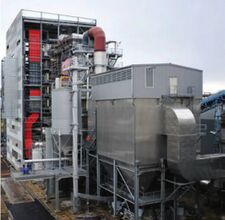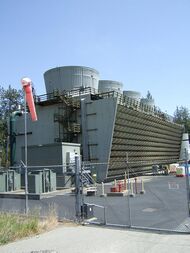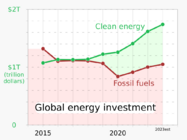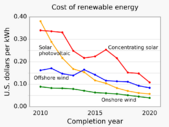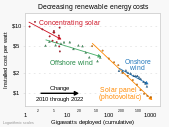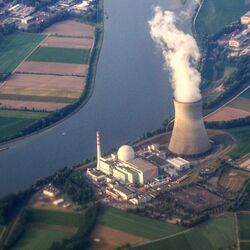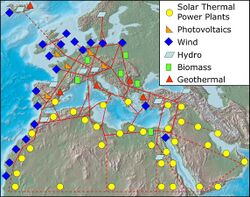Renewable energy
Topic: Engineering
 From HandWiki - Reading time: 60 min
From HandWiki - Reading time: 60 min
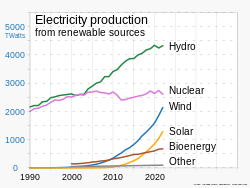
| Part of a series about |
| Sustainable energy |
|---|
 |
| Overview |
| Energy conservation |
| Renewable energy |
| Sustainable transport |
|
|
Renewable energy is energy from renewable resources that are naturally replenished on a human timescale. Renewable resources include sunlight, wind, the movement of water, and geothermal heat.[2][3] Although most renewable energy sources are sustainable, some are not. For example, some biomass sources are considered unsustainable at current rates of exploitation.[4][5] Renewable energy is often used for electricity generation, heating and cooling. Renewable energy projects are typically large-scale, but they are also suited to rural and remote areas and developing countries, where energy is often crucial in human development.[6][7]
Renewable energy is often deployed together with further electrification, which has several benefits: electricity can move heat or objects efficiently, and is clean at the point of consumption.[8][9] From 2011 to 2021, renewable energy grew from 20% to 28% of global electricity supply. Use of fossil energy shrank from 68% to 62%, and nuclear from 12% to 10%. The share of hydropower decreased from 16% to 15% while power from sun and wind increased from 2% to 10%. Biomass and geothermal energy grew from 2% to 3%. There are 3,146 gigawatts installed in 135 countries, while 156 countries have laws regulating the renewable energy sector.[10][11] In 2021, China accounted for almost half of the global increase in renewable electricity.[12]
Globally there are over 10 million jobs associated with the renewable energy industries, with solar photovoltaics being the largest renewable employer.[13] Renewable energy systems are rapidly becoming more efficient and cheaper and their share of total energy consumption is increasing,[14] with a large majority of worldwide newly installed electricity capacity being renewable.[15] In most countries, photovoltaic solar or onshore wind are the cheapest new-build electricity.[16]
Many nations around the world already have renewable energy contributing more than 20% of their total energy supply, with some generating over half their electricity from renewables.[17] A few countries generate all their electricity using renewable energy.[18] National renewable energy markets are projected to continue to grow strongly in the 2020s and beyond.[19] According to the IEA, to achieve net zero emissions by 2050, 90% of global electricity generation will need to be produced from renewable sources.[20] Some studies have shown that a global transition to 100% renewable energy across all sectors – power, heat, transport and industry – is feasible and economically viable.[21][22][23]
Renewable energy resources exist over wide geographical areas, in contrast to fossil fuels, which are concentrated in a limited number of countries. Deployment of renewable energy and energy efficiency technologies is resulting in significant energy security, climate change mitigation, and economic benefits.[24] However renewables are being hindered by hundreds of billions of dollars of fossil fuel subsidies.[25] In international public opinion surveys there is strong support for renewables such as solar power and wind power.[26][27] In 2022 the International Energy Agency asked countries to solve policy, regulatory, permitting and financing obstacles to adding more renewables, to have a better chance of reaching net zero carbon emissions by 2050.[28]
Overview
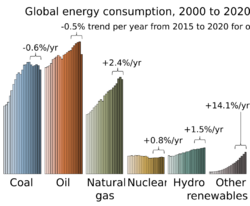
Definition
Renewable energy flows involve natural phenomena such as sunlight, wind, tides, plant growth, and geothermal heat, as the International Energy Agency explains:[30]
Renewable energy is derived from natural processes that are replenished constantly. In its various forms, it derives directly from the sun, or from heat generated deep within the earth. Included in the definition is electricity and heat generated from solar, wind, ocean, hydropower, biomass, geothermal resources, and biofuels and hydrogen derived from renewable resources.
Drivers and benefits
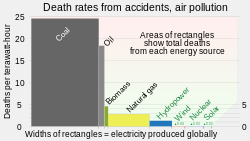
Renewable energy stands in contrast to fossil fuels, which are being used far more quickly than they are being replenished. Renewable energy resources and significant opportunities for energy efficiency exist over wide geographical areas, in contrast to other energy sources, which are concentrated in a limited number of countries. Rapid deployment of renewable energy and energy efficiency, and technological diversification of energy sources, would result in significant energy security and economic benefits.[24] Solar and wind power have got much cheaper.[32] In some cases it will be cheaper to transition to these sources as opposed to continuing to use the current, inefficient, fossil fuels. In addition, electrification with renewable energy is more efficient and therefore leads to significant reductions in primary energy requirements.[33][clarification needed]It would also reduce environmental pollution such as air pollution caused by the burning of fossil fuels, and improve public health, reduce premature mortalities due to pollution and save associated health costs that could amount to trillions of dollars annually.[34][35] Multiple analyses of decarbonization strategies have found that quantified health benefits can significantly offset the costs of implementing these strategies.[36][37]
Climate change concerns, coupled with the continuing fall in the costs of some renewable energy equipment, such as wind turbines and solar panels, are driving increased use of renewables.[26] New government spending, regulation and policies helped the industry weather the global financial crisis better than many other sectors.[38] (As of 2019), however, according to the International Renewable Energy Agency, renewables overall share in the energy mix (including power, heat and transport) needs to grow six times faster, in order to keep the rise in average global temperatures "well below" 2.0 °C (3.6 °F) during the present century, compared to pre-industrial levels.[39]
Scale
A household's solar panels, and batteries if they have them, can often either be used for just that household or if connected to an electrical grid can be aggregated with millions of others.[40] Over 44 million households use biogas made in household-scale digesters for lighting and/or cooking, and more than 166 million households rely on a new generation of more-efficient biomass cookstoves.[41][needs update]
According to the research, a nation must reach a certain point in its growth before it can take use of more renewable energy. In our words, its addition changed how crucial input factors (labor and capital) connect to one another, lowering their overall elasticity and increasing the apparent economies of scale.[42] United Nations' eighth Secretary-General Ban Ki-moon has said that renewable energy has the ability to lift the poorest nations to new levels of prosperity.[43] At the national level, at least 30 nations around the world already have renewable energy contributing more than 20% of energy supply.[44] Although many countries have various policy targets for longer-term shares of renewable energy these tend to be only for the power sector,[45] including a 40% target of all electricity generated for the European Union by 2030.[46]
Uses
Renewable energy often displaces conventional fuels in four areas: electricity generation, hot water/space heating, transportation, and rural (off-grid) energy services.[47]
More than a quarter of electricity is generated from renewables as of 2021.[48] One of the efforts to decarbonize transportation is the increased use of electric vehicles (EVs).[49] Despite that and the use of biofuels, such as biojet, less than 4% of transport energy is from renewables.[50] Occasionally hydrogen fuel cells are used for heavy transport.[51] Meanwhile, in the future electrofuels may also play a greater role in decarbonizing hard-to-abate sectors like aviation and maritime shipping.[52]
Solar water heating makes an important contribution to renewable heat in many countries, most notably in China, which now has 70% of the global total (180 GWth). Most of these systems are installed on multi-family apartment buildings[53] and meet a portion of the hot water needs of an estimated 50–60 million households in China. Worldwide, total installed solar water heating systems meet a portion of the water heating needs of over 70 million households.
Heat pumps provide both heating and cooling, and also flatten the electric demand curve and are thus an increasing priority.[54] Renewable thermal energy is also growing rapidly.[55] About 10% of heating and cooling energy is from renewables.[48]
Mainstream technologies
Solar energy
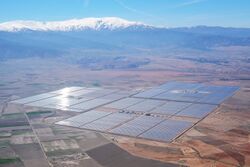
| Global electricity power generation capacity | 1053.1 GW (2022)[57] |
| Global electricity power generation capacity annual growth rate | 25% (2013-2022)[58] |
| Share of global electricity generation | 4.5% (2022)[59] |
| Levelized cost per megawatt hour | Utility-scale photovoltaics: USD 38.343 (2019)[60] |
| Primary technologies | Photovoltaics, concentrated solar power, solar thermal collector |
| Other energy applications | Water heating; heating, ventilation, and air conditioning (HVAC); cooking; process heat; water treatment |
Solar energy, radiant light and heat from the sun, is harnessed using a range of ever-evolving technologies such as solar heating, photovoltaics, concentrated solar power (CSP), concentrator photovoltaics (CPV), solar architecture and artificial photosynthesis.[61][62] Most new renewable energy is solar.[63] Solar technologies are broadly characterized as either passive solar or active solar depending on the way they capture, convert, and distribute solar energy. Passive solar techniques include orienting a building to the Sun, selecting materials with favorable thermal mass or light dispersing properties, and designing spaces that naturally circulate air. Active solar technologies encompass solar thermal energy, using solar collectors for heating, and solar power, converting sunlight into electricity either directly using photovoltaics (PV), or indirectly using concentrated solar power (CSP).
A photovoltaic system converts light into electrical direct current (DC) by taking advantage of the photoelectric effect.[64] Solar PV has turned into a multi-billion, fast-growing industry, continues to improve its cost-effectiveness, and has the most potential of any renewable technologies together with CSP.[65][66] Concentrated solar power (CSP) systems use lenses or mirrors and tracking systems to focus a large area of sunlight into a small beam. Commercial concentrated solar power plants were first developed in the 1980s. CSP-Stirling has by far the highest efficiency among all solar energy technologies.
In 2011, the International Energy Agency said that "the development of affordable, inexhaustible and clean solar energy technologies will have huge longer-term benefits. It will increase countries' energy security through reliance on an indigenous, inexhaustible and mostly import-independent resource, enhance sustainability, reduce pollution, lower the costs of mitigating climate change, and keep fossil fuel prices lower than otherwise. These advantages are global. Hence the additional costs of the incentives for early deployment should be considered learning investments; they must be wisely spent and need to be widely shared".[61] Solar power accounts for 505 GW annually, which is about 2% of the world's electricity. Solar energy can be harnessed anywhere that receives sunlight; however, the amount of solar energy that can be harnessed for electricity generation is influenced by weather conditions, geographic location and time of day.[67]
According to chapter 6 of the IPCC 2022 climate mitigation report, the global potential of direct solar energy far exceeds that of any other renewable energy resource. It is well beyond the total amount of energy needed in order to support mitigation over the current century.[49] Australia has the largest proportion of solar electricity in the world, supplying 9.9% of the country's electrical demand in 2020.[68] More than 30 per cent of Australian households now have rooftop solar PV, with a combined capacity exceeding 11 GW.[69]
There are, however, environmental implications of scaling up solar energy. In particular, the demand for raw materials such as aluminum poses concerns over the carbon footprint that will result from harvesting raw materials needed to implement solar energy.[70]
Photovoltaic development
Photovoltaics (PV) is rapidly-growing with global capacity increasing from 230 GW at the end of 2015 to 890 GW in 2021.[71]
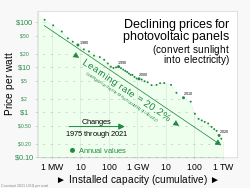
PV uses solar cells assembled into solar panels to convert sunlight into electricity. PV systems range from small, residential and commercial rooftop or building integrated installations, to large utility-scale photovoltaic power station. The predominant PV technology is crystalline silicon, while thin-film solar cell technology accounts for about 10 percent of global photovoltaic deployment. In recent years, PV technology has improved its electricity generating efficiency, reduced the installation cost per watt as well as its energy payback time, and reached grid parity.[74]
Building-integrated photovoltaics or "onsite" PV systems use existing land and structures and generate power close to where it is consumed.[75]
Photovoltaics grew fastest in China between 2016 and 2021 adding 560 GW, more than all advanced economies combined. Solar PV's installed power capacity is poised to surpass that of coal by 2027, becoming the largest in the world.[76] This requires an increase of installed PV capacity to 4,600 GW, of which more than half is expected to be deployed in China and India.[77][78]
Commercial concentrated solar power plants were first developed in the 1980s. As the cost of solar electricity has fallen, the number of grid-connected solar PV systems has grown into the millions and gigawatt-scale solar power stations are being built. Many solar photovoltaic power stations have been built, mainly in Europe, China and the United States.[79] The 1.5 GW Tengger Desert Solar Park, in China is the world's largest PV power station. Many of these plants are integrated with agriculture and some use tracking systems that follow the sun's daily path across the sky to generate more electricity than fixed-mounted systems.
Solar thermal
Wind power
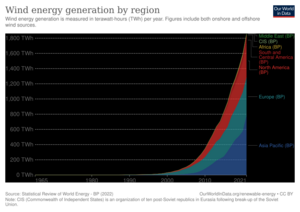
| Global electricity power generation capacity | 898.8 GW (2022)[81] |
| Global electricity power generation capacity annual growth rate | 13% (2013-2022)[82] |
| Share of global electricity generation | 7.6% (2022)[59] |
| Levelized cost per megawatt hour | Land-based wind: USD 30.165 (2019)[83] |
| Primary technology | Wind turbine |
| Other energy applications | Windmill, windpump |
Air flow can be used to run wind turbines. Modern utility-scale wind turbines range from around 600 kW to 9 MW of rated power. The power available from the wind is a function of the cube of the wind speed, so as wind speed increases, power output increases up to the maximum output for the particular turbine.[84] Areas where winds are stronger and more constant, such as offshore and high-altitude sites, are preferred locations for wind farms.
Wind-generated electricity met nearly 4% of global electricity demand in 2015, with nearly 63 GW of new wind power capacity installed. Wind energy was the leading source of new capacity in Europe, the US and Canada, and the second largest in China. In Denmark, wind energy met more than 40% of its electricity demand while Ireland, Portugal and Spain each met nearly 20%.[85]
Globally, the long-term technical potential of wind energy is believed to be five times total current global energy production, or 40 times current electricity demand, assuming all practical barriers needed were overcome. This would require wind turbines to be installed over large areas, particularly in areas of higher wind resources, such as offshore, and likely also industrial use of new types of VAWT turbines in addition to the horizontal axis units currently in use. As offshore wind speeds average ~90% greater than that of land, offshore resources can contribute substantially more energy than land-stationed turbines.[86]
Hydropower
| Global electricity power generation capacity | 1,255.5 GW (2022)[87] |
| Global electricity power generation capacity annual growth rate | 2.2% (2013-2022)[88] |
| Share of global electricity generation | 15% (2022)[59] |
| Levelized cost per megawatt hour | USD 65.581 (2019)[89] |
| Primary technology | Dam |
| Other energy applications | Pumped storage, mechanical power |
Since water is about 800 times denser than air, even a slow flowing stream of water, or moderate sea swell, can yield considerable amounts of energy. Water can generate electricity with a conversion efficiency of about 90%, which is the highest rate in renewable energy.[90] There are many forms of water energy:
- Historically, hydroelectric power came from constructing large hydroelectric dams and reservoirs, which are still popular in developing countries.[91] The largest of them are the Three Gorges Dam (2003) in China and the Itaipu Dam (1984) built by Brazil and Paraguay.
- Small hydro systems are hydroelectric power installations that typically produce up to 50 MW of power. They are often used on small rivers or as a low-impact development on larger rivers. China is the largest producer of hydroelectricity in the world and has more than 45,000 small hydro installations.[92]
- Run-of-the-river hydroelectricity plants derive energy from rivers without the creation of a large reservoir. The water is typically conveyed along the side of the river valley (using channels, pipes and/or tunnels) until it is high above the valley floor, whereupon it can be allowed to fall through a penstock to drive a turbine. A run-of-river plant may still produce a large amount of electricity, such as the Chief Joseph Dam on the Columbia River in the United States.[93] However many run-of-the-river hydro power plants are micro hydro or pico hydro plants.
Hydropower is produced in 150 countries, with the Asia-Pacific region generating 32 percent of global hydropower in 2010.[needs update] Of the top 50 countries by percentage of electricity generated from renewables, 46 are primarily hydroelectric.[94] There are now seven hydroelectricity stations larger than 10 GW (10,000 MW) worldwide, see table below.
| Rank | Station | Country | Location | Capacity (MW) |
|---|---|---|---|---|
| 1. | Three Gorges Dam | [ ⚑ ] 30°49′15″N 111°00′08″E / 30.82083°N 111.00222°E | 22,500 | |
| 2. | Baihetan Dam | [ ⚑ ] 27°13′23″N 102°54′11″E / 27.22306°N 102.90306°E | 16,000 | |
| 3. | Itaipu Dam | [ ⚑ ] 25°24′31″S 54°35′21″W / 25.40861°S 54.58917°W | 14,000 | |
| 4. | Xiluodu Dam | [ ⚑ ] 28°15′35″N 103°38′58″E / 28.25972°N 103.64944°E | 13,860 | |
| 5. | Belo Monte Dam | [ ⚑ ] 03°06′57″S 51°47′45″W / 3.11583°S 51.79583°W | 11,233 | |
| 6. | Guri Dam | [ ⚑ ] 07°45′59″N 62°59′57″W / 7.76639°N 62.99917°W | 10,235 | |
| 7. | Wudongde Dam | [ ⚑ ] 26°20′2″N 102°37′48″E / 26.33389°N 102.63°E | 10,200 |
Much hydropower is flexible, thus complementing wind and solar.[95] Wave power, which captures the energy of ocean surface waves, and tidal power, converting the energy of tides, are two forms of hydropower with future potential; however, they are not yet widely employed commercially.[96] A demonstration project operated by the Ocean Renewable Power Company on the coast of Maine, and connected to the grid, harnesses tidal power from the Bay of Fundy, location of the world's highest tidal flow. Ocean thermal energy conversion, which uses the temperature difference between cooler deep and warmer surface waters, currently has no economic feasibility.[97][98]
In 2021, the world renewable hydropower capacity was 1,360 GW.[76] Only a third of the world's estimated hydroelectric potential of 14,000 TWh/year has been developed.[99][100] New hydropower projects face opposition from local communities due to their large impact, including relocation of communities and flooding of wildlife habitats and farming land.[101] High cost and lead times from permission process, including environmental and risk assessments, with lack of environmental and social acceptance are therefore the primary challenges for new developments.[102] It is popular to repower old dams thereby increasing their efficiency and capacity as well as quicker responsiveness on the grid.[103] Where circumstances permit existing dams such as the Russell Dam built in 1985 may be updated with "pump back" facilities for pumped-storage which is useful for peak loads or to support intermittent wind and solar power. Because dispatchable power is more valuable than VRE[104][105] countries with large hydroelectric developments such as Canada and Norway are spending billions to expand their grids to trade with neighboring countries having limited hydro.[106]
Bioenergy
| Global electricity power generation capacity | 148.9 GW (2022)[107] |
| Global electricity power generation capacity annual growth rate | 6.5% (2013-2022)[108] |
| Share of global electricity generation | 2.4% (2022)[59] |
| Levelized cost per megawatt hour | USD 118.908 (2019)[109] |
| Primary technologies | biomass, biofuel |
| Other energy applications | Heating, cooking, transportation fuels |
Biomass is biological material derived from living, or recently living organisms. It commonly refers to plants or plant-derived materials. As an energy source, biomass can either be used directly via combustion to produce heat, or indirectly after converting it to various forms of biofuel in solid, liquid or gaseous form. Conversion of biomass to biofuel can be achieved by different methods which are broadly classified into: thermal, chemical, and biochemical methods. Wood was the largest biomass energy source as of 2012;[110] examples include forest residues – such as dead trees, branches and tree stumps, yard clippings, wood chips and even municipal solid waste. Industrial biomass can be grown from numerous types of plants, including miscanthus, switchgrass, hemp, corn, poplar, willow, sorghum, sugarcane, bamboo,[111] and a variety of tree species, ranging from eucalyptus to oil palm (palm oil).
Plant energy is produced by crops specifically grown for use as fuel that offer high biomass output per hectare with low input energy.[112] The grain can be used for liquid transportation fuels while the straw can be burned to produce heat or electricity. Plant biomass can also be degraded from cellulose to glucose through a series of chemical treatments, and the resulting sugar can then be used as a first-generation biofuel.
Biomass can be converted to other usable forms of energy such as methane gas[113] or transportation fuels such as ethanol and biodiesel. Rotting garbage, and agricultural and human waste, all release methane gas – also called landfill gas or biogas. Crops, such as corn and sugarcane, can be fermented to produce the transportation fuel, ethanol. Biodiesel, another transportation fuel, can be produced from left-over food products such as vegetable oils and animal fats.[114] There is a great deal of research involving algal fuel or algae-derived biomass due to the fact that it is a non-food resource, grows around 20 times faster than other types of food crops, such as corn and soy, and can be grown almost anywhere.[115][116] Once harvested, it can be fermented to produce biofuels such as ethanol, butanol, and methane, as well as biodiesel and hydrogen. The biomass used for electricity generation varies by region. Forest by-products, such as wood residues, are common in the United States. Agricultural waste is common in Mauritius (sugar cane residue) and Southeast Asia (rice husks).
Biomass, biogas and biofuels are burned to produce heat/power and in doing so can harm the environment. Pollutants such as sulphurous oxides (SOx), nitrous oxides (NOx), and particulate matter (PM) are produced from the combustion of biomass. With regards to traditional use of biomass for heating and cooking, the World Health Organization estimates that 3.7 million prematurely died from outdoor air pollution in 2012 while indoor pollution from biomass burning effects over 3 billion people worldwide.[117][118]
Bioenergy global capacity in 2021 was 158 GW. Biofuels avoided 4.4% of global transport fuel demand in 2021.[76]
Biofuel
Biofuels include a wide range of fuels which are derived from biomass. The term covers solid, liquid, and gaseous fuels.[119] Liquid biofuels include bioalcohols, such as bioethanol, and oils, such as biodiesel. Gaseous biofuels include biogas, landfill gas and synthetic gas. Bioethanol is an alcohol made by fermenting the sugar components of plant materials and it is made mostly from sugar and starch crops. These include maize, sugarcane and, more recently, sweet sorghum. The latter crop is particularly suitable for growing in dryland conditions, and is being investigated by International Crops Research Institute for the Semi-Arid Tropics for its potential to provide fuel, along with food and animal feed, in arid parts of Asia and Africa.[120]
With advanced technology being developed, cellulosic biomass, such as trees and grasses, are also used as feedstocks for ethanol production. Ethanol can be used as a fuel for vehicles in its pure form, but it is usually used as a gasoline additive to increase octane and improve vehicle emissions. Bioethanol is widely used in the United States and in Brazil. The energy costs for producing bio-ethanol are almost equal to, the energy yields from bio-ethanol. However, according to the European Environment Agency, biofuels do not address global warming concerns.[121] Biodiesel is made from vegetable oils, animal fats or recycled greases. It can be used as a fuel for vehicles in its pure form, or more commonly as a diesel additive to reduce levels of particulates, carbon monoxide, and hydrocarbons from diesel-powered vehicles. Biodiesel is produced from oils or fats using transesterification and is the most common biofuel in Europe. Biofuels provided 2.7% of the world's transport fuel in 2010.[122][needs update]
Policies in more than 80 countries support biofuels demand.[76]
Since the 1970s, Brazil has had an ethanol fuel program which has allowed the country to become the world's second largest producer of ethanol (after the United States) and the world's largest exporter.[123] Brazil's ethanol fuel program uses modern equipment and cheap sugarcane as feedstock, and the residual cane-waste (bagasse) is used to produce heat and power.[124] There are no longer light vehicles in Brazil running on pure gasoline.[125]
Biojet is expected to be important for short-term reduction of carbon dioxide emissions from long-haul flights.[126]
Geothermal energy
| Global electricity power generation capacity | 14.9 GW (2022)[127] |
| Global electricity power generation capacity annual growth rate | 3.4% (2013-2022)[128] |
| Share of global electricity generation | <1% (2018)[129] |
| Levelized cost per megawatt hour | USD 58.257 (2019)[130] |
| Primary technologies | Dry steam, flash steam, and binary cycle power stations |
| Other energy applications | Heating |
High temperature geothermal energy is from thermal energy generated and stored in the Earth. Thermal energy is the energy that determines the temperature of matter. Earth's geothermal energy originates from the original formation of the planet and from radioactive decay of minerals (in currently uncertain[131] but possibly roughly equal[132] proportions). The geothermal gradient, which is the difference in temperature between the core of the planet and its surface, drives a continuous conduction of thermal energy in the form of heat from the core to the surface. The adjective geothermal originates from the Greek roots geo, meaning earth, and thermos, meaning heat.
The heat that is used for geothermal energy can be from deep within the Earth, all the way down to Earth's core – 6,400 kilometres (4,000 mi) down. At the core, temperatures may reach over 5,000 °C (9,030 °F). Heat conducts from the core to the surrounding rock. Extremely high temperature and pressure cause some rock to melt, which is commonly known as magma. Magma convects upward since it is lighter than the solid rock. This magma then heats rock and water in the crust, sometimes up to 371 °C (700 °F).[133]
Low temperature geothermal[54] refers to the use of the outer crust of the Earth as a thermal battery to facilitate renewable thermal energy for heating and cooling buildings, and other refrigeration and industrial uses. In this form of geothermal, a geothermal heat pump and ground-coupled heat exchanger are used together to move heat energy into the Earth (for cooling) and out of the Earth (for heating) on a varying seasonal basis. Low-temperature geothermal (generally referred to as "GHP"[clarification needed]) is an increasingly important renewable technology because it both reduces total annual energy loads associated with heating and cooling, and it also flattens the electric demand curve eliminating the extreme summer and winter peak electric supply requirements. Thus low temperature geothermal/GHP is becoming an increasing national[clarification needed] priority with multiple tax credit support[134] and focus as part of the ongoing movement toward net zero energy.[135]
Geothermal power is cost effective, reliable, sustainable, and environmentally friendly,[136] but has historically been limited to areas near tectonic plate boundaries. Recent technological advances have expanded the range and size of viable resources, especially for applications such as home heating, opening a potential for widespread exploitation. Geothermal wells release greenhouse gases trapped deep within the earth, but these emissions are usually much lower per energy unit than those of fossil fuels. As a result, geothermal power has the potential to help mitigate global warming if widely deployed in place of fossil fuels.
In 2017, the United States led the world in geothermal electricity production with 12.9 GW of installed capacity.[71] The largest group of geothermal power plants in the world is located at The Geysers, a geothermal field in California.[137] The Philippines follows the US as the second highest producer of geothermal power in the world, with 1.9 GW of capacity online.[71]
Global geothermal capacity in 2021 was 15 GW.[76]
Emerging technologies
There are also other renewable energy technologies that are still under development, including cellulosic ethanol, hot-dry-rock geothermal power, and marine energy.[138] These technologies are not yet widely demonstrated or have limited commercialization. Many are on the horizon and may have potential comparable to other renewable energy technologies, but still depend on attracting sufficient attention and research, development and demonstration (RD&D) funding.[138]
There are numerous organizations within the academic, federal,[clarification needed] and commercial sectors conducting large-scale advanced research in the field of renewable energy. This research spans several areas of focus across the renewable energy spectrum. Most of the research is targeted at improving efficiency and increasing overall energy yields.[139] Multiple government supported research organizations have focused on renewable energy in recent years. Two of the most prominent of these labs are Sandia National Laboratories and the National Renewable Energy Laboratory (NREL), both of which are funded by the United States Department of Energy and supported by various corporate partners.[140]
Enhanced geothermal system

Enhanced geothermal systems (EGS) are a new type of geothermal power technology that does not require natural convective hydrothermal resources. The vast majority of geothermal energy within drilling reach is in dry and non-porous rock.[141] EGS technologies "enhance" and/or create geothermal resources in this "hot dry rock (HDR)" through hydraulic fracturing. EGS and HDR technologies, such as hydrothermal geothermal, are expected to be baseload resources that produce power 24 hours a day like a fossil plant. Distinct from hydrothermal, HDR and EGS may be feasible anywhere in the world, depending on the economic limits of drill depth. Good locations are over deep granite covered by a thick (3–5 km or 1.9–3.1 mi) layer of insulating sediments which slow heat loss.[142] There are HDR and EGS systems currently being developed and tested in France, Australia, Japan, Germany, the U.S., and Switzerland. The largest EGS project in the world is a 25 megawatt demonstration plant currently being developed in the Cooper Basin, Australia. The Cooper Basin has the potential to generate 5,000–10,000 MW.
Hydrogen
Marine energy
Marine energy (also sometimes referred to as ocean energy) is the energy carried by ocean waves, tides, salinity, and ocean temperature differences. The movement of water in the world's oceans creates a vast store of kinetic energy, or energy in motion. This energy can be harnessed to generate electricity to power homes, transport and industries. The term marine energy encompasses wave power – power from surface waves, marine current power - power from marine hydrokinetic streams (e.g., the Gulf Stream), and tidal power – obtained from the kinetic energy of large bodies of moving water. Reverse electrodialysis (RED) is a technology for generating electricity by mixing fresh river water and salty sea water in large power cells designed for this purpose; as of 2016, it is being tested at a small scale (50 kW). Offshore wind power is not a form of marine energy, as wind power is derived from the wind, even if the wind turbines are placed over water. The oceans have a tremendous amount of energy and are close to many if not most concentrated populations. Ocean energy has the potential of providing a substantial amount of new renewable energy around the world.[143][144][page needed]
| # | Station | Country | Location | Capacity | Refs |
|---|---|---|---|---|---|
| 1. | Sihwa Lake Tidal Power Station | South Korea | [ ⚑ ] 37°18′47″N 126°36′46″E / 37.31306°N 126.61278°E | 254 MW | [145] |
| 2. | Rance Tidal Power Station | France | [ ⚑ ] 48°37′05″N 02°01′24″W / 48.61806°N 2.02333°W | 240 MW | [146] |
| 3. | Annapolis Royal Generating Station | Canada | [ ⚑ ] 44°45′07″N 65°30′40″W / 44.75194°N 65.51111°W | 20 MW | [146] |
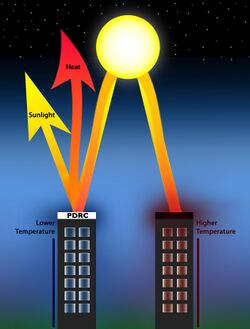
Passive daytime radiative cooling
Passive daytime radiative cooling (PDRC) uses the coldness of outer space as a renewable energy source to achieve daytime cooling that can be used in many applications,[148][149][150] such as indoor space cooling,[151][152] outdoor urban heat island mitigation,[153][154] and solar cell efficiency.[155][156] PDRC surfaces are designed to be high in solar reflectance to minimize heat gain and strong in longwave infrared (LWIR) thermal radiation heat transfer.[157] On a planetary scale, it has been proposed as a way to slow and reverse global warming.[147][158] PDRC applications are deployed as sky-facing surfaces, similar to other renewable energy sources such as photovoltaic systems and solar thermal collectors.[156] PDRC became possible with the ability to suppress solar heating using photonic metamaterials, first published in a study by Raman et al. to the scientific community in 2014.[155][159] PDRC applications for indoor space cooling is growing with an estimated "market size of ~$27 billion in 2025."[160]
Artificial photosynthesis
Artificial photosynthesis uses techniques including nanotechnology to store solar electromagnetic energy in chemical bonds by splitting water to produce hydrogen and then using carbon dioxide to make methanol.[161] Researchers in this field strived to design molecular mimics of photosynthesis that use a wider region of the solar spectrum, employ catalytic systems made from abundant, inexpensive materials that are robust, readily repaired, non-toxic, stable in a variety of environmental conditions and perform more efficiently allowing a greater proportion of photon energy to end up in the storage compounds, i.e., carbohydrates (rather than building and sustaining living cells).[162] However, prominent research faces hurdles, Sun Catalytix a MIT spin-off stopped scaling up their prototype fuel-cell in 2012 because it offers few savings over other ways to make hydrogen from sunlight.[163]
Earth infrared thermal radiation
Earth emits roughly 1017 W of infrared thermal radiation that flows toward the cold outer space. Solar energy hits the surface and atmosphere of the earth and produces heat. Using various theorized devices like emissive energy harvester (EEH) or thermoradiative diode, this energy flow can be converted into electricity. In theory, this technology can be used during nighttime.[164][165]
Others
Algae fuels
Producing liquid fuels from oil-rich (fat-rich) varieties of algae is an ongoing research topic. Various microalgae grown in open or closed systems are being tried including some systems that can be set up in brownfield and desert lands.[166]
Water vapor
Collection of static electricity charges from water droplets on metal surfaces is an experimental technology that would be especially useful in low-income countries with relative air humidity over 60%.[167]
Nuclear energy
Breeder reactors could, in principle, extract almost all of the energy contained in uranium or thorium, decreasing fuel requirements by a factor of 100 compared to widely used once-through light water reactors, which extract less than 1% of the energy in the actinide metal (uranium or thorium) mined from the earth.[168] The high fuel-efficiency of breeder reactors could greatly reduce concerns about fuel supply, energy used in mining, and storage of radioactive waste. With seawater uranium extraction (currently too expensive to be economical), there is enough fuel for breeder reactors to satisfy the world's energy needs for 5 billion years at 1983's total energy consumption rate, thus making nuclear energy effectively a renewable energy.[169][170] In addition to seawater the average crustal granite rocks contain significant quantities of uranium and thorium that with breeder reactors can supply abundant energy for the remaining lifespan of the sun on the main sequence of stellar evolution.[171]
Integration into the energy system and sector coupling

Renewable energy production from some sources such as wind and solar is more variable and more geographically spread than technology based on fossil fuels and nuclear. While integrating it into the wider energy system is feasible, it does lead to some additional challenges such as increased production volatility and decreased system inertia.[172] Implementation of energy storage, using a wide variety of renewable energy technologies, and implementing a smart grid in which energy is automatically used at the moment it is produced can reduce risks and costs of renewable energy implementation.[172][173]:15–16
Sector coupling of the power generation sector with other sectors may increase flexibility: for example the transport sector can be coupled by charging electric vehicles and sending electricity from vehicle to grid.[174] Similarly the industry sector can be coupled by hydrogen produced by electrolysis,[175] and the buildings sector by thermal energy storage for space heating and cooling.[176]
Electrical energy storage
Electrical energy storage is a collection of methods used to store electrical energy. Electrical energy is stored during times when production (especially from intermittent sources such as wind power, tidal power, solar power) exceeds consumption, and returned to the grid when production falls below consumption. Pumped-storage hydroelectricity accounts for more than 85% of all grid power storage.[177] Batteries are increasingly being deployed for storage[178] and grid ancillary services[179] and for domestic storage.[180] Green hydrogen is a more economical means of long-term renewable energy storage, in terms of capital expenditures compared to pumped hydroelectric or batteries.[181][182]
Market and industry trends
Most new renewables are solar, followed by wind then hydro then bioenergy.[183] Investment in renewables, especially solar, tends to be more effective in creating jobs than coal, gas or oil.[184][185] Worldwide, renewables employ about 12 million people as of 2020, with solar PV being the technology employing the most at almost 4 million.[186]
Cost comparison
The International Renewable Energy Agency (IRENA) stated that ~86% (187 GW) of renewable capacity added in 2022 had lower costs than electricity generated from fossil fuels.[187] IRENA also stated that capacity added since 2000 reduced electricity bills in 2022 by at least $520 billion, and that in non-OECD countries, the lifetime savings of 2022 capacity additions will reduce costs by up to $580 billion.[187]
| Installed[188] TWp |
Growth TW/yr[188] |
Production per installed capacity*[189] |
Energy TWh/yr*[189] |
Growth TWh/yr*[189] |
Levelized cost US¢/kWh[190] |
Av. auction prices US¢/kWh[191] |
Cost development 2010–2019[190] | |
|---|---|---|---|---|---|---|---|---|
| Solar PV | 0.580 | 0.098 | 13% | 549 | 123 | 6.8 | 3.9 | −82% |
| Solar CSP | 0.006 | 0.0006 | 13% | 6.3 | 0.5 | 18.2 | 7.5 | −47% |
| Wind Offshore | 0.028 | 0.0045 | 33% | 68 | 11.5 | 11.5 | 8.2 | −30% |
| Wind Onshore | 0.594 | 0.05 | 25% | 1194 | 118 | 5.3 | 4.3 | −38% |
| Hydro | 1.310 | 0.013 | 38% | 4267 | 90 | 4.7 | +27% | |
| Bioenergy | 0.12 | 0.006 | 51% | 522 | 27 | 6.6 | −13% | |
| Geothermal | 0.014 | 0.00007 | 74% | 13.9 | 0.7 | 7.3 | +49% |
* = 2018. All other values for 2019.
Growth of renewables
Levelized cost of energy (LCOE) is a measure of the average net present cost of electricity generation for a generating plant over its lifetime.
The results of a recent review of the literature concluded that as greenhouse gas (GHG) emitters begin to be held liable for damages resulting from GHG emissions resulting in climate change, a high value for liability mitigation would provide powerful incentives for deployment of renewable energy technologies.[202]
In the decade of 2010–2019, worldwide investment in renewable energy capacity excluding large hydropower amounted to US$2.7 trillion, of which the top countries China contributed US$818 billion, the United States contributed US$392.3 billion, Japan contributed US$210.9 billion, Germany contributed US$183.4 billion, and the United Kingdom contributed US$126.5 billion.[203] This was an increase of over three and possibly four times the equivalent amount invested in the decade of 2000–2009 (no data is available for 2000–2003).[203]
As of 2022, an estimated 28% of the world's electricity was generated by renewables. This is up from 19% in 1990.[204]
Future projections

A December 2022 report by the IEA forecasts that over 2022-2027, renewables are seen growing by almost 2 400 GW in its main forecast, equal to the entire installed power capacity of China in 2021. This is an 85% acceleration from the previous five years, and almost 30% higher than what the IEA forecast in its 2021 report, making its largest ever upward revision. Renewables are set to account for over 90% of global electricity capacity expansion over the forecast period.[76] To achieve net zero emissions by 2050, IEA believes that 90% of global electricity generation will need to be produced from renewable sources.[20]
In June 2022 IEA Executive Director Fatih Birol said that countries should invest more in renewables to "ease the pressure on consumers from high fossil fuel prices, make our energy systems more secure, and get the world on track to reach our climate goals.”[206]
China's five year plan to 2025 includes increasing direct heating by renewables such as geothermal and solar thermal.[207]
REPowerEU, the EU plan to escape dependence on fossil Russian gas, is expected to call for much more green hydrogen.[208]
After a transitional period,[209] renewable energy production is expected to make up most of the world's energy production. In 2018, the risk management firm, DNV GL, forecasts that the world's primary energy mix will be split equally between fossil and non-fossil sources by 2050.[210]
Demand
In July 2014, WWF and the World Resources Institute convened a discussion among a number of major US companies who had declared their intention to increase their use of renewable energy. These discussions identified a number of "principles" which companies seeking greater access to renewable energy considered important market deliverables. These principles included choice (between suppliers and between products), cost competitiveness, longer term fixed price supplies, access to third-party financing vehicles, and collaboration.[211]
UK statistics released in September 2020 noted that "the proportion of demand met from renewables varies from a low of 3.4 per cent (for transport, mainly from biofuels) to highs of over 20 per cent for 'other final users', which is largely the service and commercial sectors that consume relatively large quantities of electricity, and industry".[212]
In some locations, individual households can opt to purchase renewable energy through a consumer green energy program.
Developing countries
In Kenya, the Olkaria V Geothermal Power Station is one of the largest in the world.[213] The Grand Ethiopia Renaissance Dam project incorporates wind turbines.[214] Once completed, Morocco's Ouarzazate Solar Power Station is projected to provide power to over a million people.[215]
Policy

Policies to support renewable energy have been vital in their expansion. Where Europe dominated in establishing energy policy in the early 2000s, most countries around the world now have some form of energy policy.[217]
Policy trends
The International Renewable Energy Agency (IRENA) is an intergovernmental organization for promoting the adoption of renewable energy worldwide. It aims to provide concrete policy advice and facilitate capacity building and technology transfer. IRENA was formed in 2009, with 75 countries signing the charter of IRENA.[218] As of April 2019, IRENA has 160 member states.[219] The then United Nations Secretary-General Ban Ki-moon has said that renewable energy can lift the poorest nations to new levels of prosperity,[43] and in September 2011 he launched the UN Sustainable Energy for All initiative to improve energy access, efficiency and the deployment of renewable energy.[220]
The 2015 Paris Agreement on climate change motivated many countries to develop or improve renewable energy policies.[19] In 2017, a total of 121 countries adopted some form of renewable energy policy.[217] National targets that year existed in 176 countries.[19] In addition, there is also a wide range of policies at the state/provincial, and local levels.[122] Some public utilities help plan or install residential energy upgrades.
Many national, state and local governments have created green banks. A green bank is a quasi-public financial institution that uses public capital to leverage private investment in clean energy technologies.[221] Green banks use a variety of financial tools to bridge market gaps that hinder the deployment of clean energy.
Climate neutrality by the year 2050 is the main goal of the European Green Deal.[222] For the European Union to reach their target of climate neutrality, one goal is to decarbonise its energy system by aiming to achieve "net-zero greenhouse gas emissions by 2050."[223]
Full renewable energy
100% renewable energy means getting all energy from renewable resources. The endeavor to use 100% renewable energy for electricity, heating, cooling and transport is motivated by climate change, pollution and other environmental issues, as well as economic and energy security concerns. Shifting the total global primary energy supply to renewable sources requires a transition of the energy system, since most of today's energy is derived from non-renewable fossil fuels.
Research into this topic is fairly new, with very few studies published before 2009, but has gained increasing attention in recent years. The majority of studies show that a global transition to 100% renewable energy across all sectors – power, heat, transport and desalination – is feasible and economically viable.[224][225][226][227] A cross-sectoral, holistic approach is seen as an important feature of 100% renewable energy systems and is based on the assumption "that the best solutions can be found only if one focuses on the synergies between the sectors" of the energy system such as electricity, heat, transport or industry.[228]
The main barriers to the widespread implementation of large-scale renewable energy and low-carbon energy strategies are seen to be primarily social and political rather than technological or economic.[229] According to the 2013 Post Carbon Pathways report, which reviewed many international studies, the key roadblocks are: climate change denial, the fossil fuels lobby, political inaction, unsustainable energy consumption, outdated energy infrastructure, and financial constraints.[230]Debates
Renewable electricity generation by wind and solar is variable. This results in reduced capacity factor and may require keeping some gas-fired power plants or other dispatchable generation on standby[233][234][235] until there is enough energy storage, demand response, grid improvement, and/or base load power from non-intermittent sources like hydropower, nuclear power or bioenergy.
The market for renewable energy technologies has continued to grow. Climate change concerns and increasing in green jobs, coupled with high oil prices, peak oil, oil wars, oil spills, promotion of electric vehicles and renewable electricity, nuclear disasters and increasing government support, are driving increasing renewable energy legislation, incentives and commercialization.[26][better source needed]
The International Energy Agency has stated that deployment of renewable technologies usually increases the diversity of electricity sources and, through local generation, contributes to the flexibility of the system and its resistance to central shocks.[236]
Public support
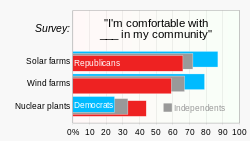
Solar power plants may compete with arable land,[238][239] while on-shore wind farms face opposition due to aesthetic concerns and noise, which is impacting both humans and wildlife.[240][241][242][need quotation to verify]In the United States, the Massachusetts Cape Wind project was delayed for years partly because of aesthetic concerns. However, residents in other areas have been more positive. According to a town councilor, the overwhelming majority of locals believe that the Ardrossan Wind Farm in Scotland has enhanced the area.[243] These concerns, when directed against renewable energy, are sometimes described as "not in my back yard" attitude (NIMBY).
A 2011 UK Government document states that "projects are generally more likely to succeed if they have broad public support and the consent of local communities. This means giving communities both a say and a stake".[244] In countries such as Germany and Denmark many renewable projects are owned by communities, particularly through cooperative structures, and contribute significantly to overall levels of renewable energy deployment.[245][246]
Nuclear power proposed as renewable energy
Geopolitics
From around 2010 onwards, the geopolitical impact of the growing use of renewable energy has been discussed.[247] Some argue that former fossil fuels exporters will experience a weakening of their position in international affairs, while countries with abundant renewable energy resources will be strengthened.[248] Also some countries rich in critical materials for renewable energy technologies are expected to rise in importance in international affairs.[249][250]
The GeGaLo index of geopolitical gains and losses assesses how the geopolitical position of 156 countries may change if the world fully transitions to renewable energy resources. Former fossil fuels exporters are expected to lose power, while the positions of former fossil fuel importers and countries rich in renewable energy resources is expected to strengthen.[251] Sourcing of required materials, ownership of key infrastructure assets and the design of grids all require geopolitics consideration.[252][253][254]
Transitions to renewable energy have many geopolitical implications such as the potential of revenue losses leading to political instability in insufficiently prepared fossil-fuel-exporting economies, albeit it is unclear whether the transition will increase or reduce conflict overall. In particular, a study hypothesizes that a "configuration emerges in which fossil fuel importers are better off decarbonizing, competitive fossil fuel exporters are better off flooding markets and uncompetitive fossil fuel producers—rather than benefitting from 'free-riding'—suffer from their exposure to stranded assets and lack of investment in decarbonization technologies".[255][256]
A study found that transition from fossil fuels to renewable energy systems reduces risks from mining, trade and political dependence because renewable energy systems don't need fuel – they depend on trade only for the acquisition of materials and components during construction.[257]
Nations rich in solar and wind energy could become major energy exporters.[258]
Trade in hydrogen could fundamentally redraw the geography of the global energy trade, and international governance and investments that seek to scale up the hydrogen economy could reduce "the risk of market fragmentation, carbon lock-in, and intensified geo-economic rivalry".[259][258][260] Electricity will overtake other energy carriers by 2050, accounting for almost 50% of total energy consumption (up from 22% in 2015). Given the limitations of using solely electricity, clean hydrogen has significant potential in a number of industries.[261][262] Hydrogen has the potential to be long-term stored in the electricity and heating industries.[263]
In 2019, oil and gas companies were listed by Forbes with sales of US$4.8 trillion, about 5% of the global GDP.[264] Net importers such as China and the EU would gain advantages from a transition to low-carbon technologies driven by technological development, energy efficiency or climate change policy, while Russia, the USA or Canada could see their fossil fuel industries nearly shut down.[265] On the other hand, countries with large areas such as Australia, Russia, China, the US, Canada and Brazil and also Africa and the Middle East have a potential for huge installations of renewable energy. The production of renewable energy technologies requires rare-earth elements with new supply chains.[266]
In October 2021, European Commissioner for Climate Action Frans Timmermans suggested "the best answer" to the 2021 global energy crisis is "to reduce our reliance on fossil fuels."[267] He said those blaming the European Green Deal were doing so "for perhaps ideological reasons or sometimes economic reasons in protecting their vested interests."[267] Some critics blamed the European Union Emissions Trading System (EU ETS) and closure of nuclear plants for contributing to the energy crisis.[268][269][270] European Commission President Ursula von der Leyen said that Europe is "too reliant" on natural gas and too dependent on natural gas imports. According to Von der Leyen, "The answer has to do with diversifying our suppliers ... and, crucially, with speeding up the transition to clean energy."[271]
Metal and mineral extraction
The renewable energy transition requires increased extraction of certain metals and minerals.[272] This impacts the environment and can lead to environmental conflict.[273]
The International Energy Agency does not recognise shortages of resources but states that supply could struggle to keep pace with the world's climate ambitions. Electric vehicles (EV) and battery storage are expected to cause the most demand. Wind farms and solar PV are less consuming. The extension of electrical grids requires large amounts of copper and aluminium. The IEA recommends to scale up recycling. By 2040, quantities of copper, lithium, cobalt, and nickel from spent batteries could reduce combined primary supply requirements for these minerals by around 10%.[272]
The demand for lithium by 2040 is expected to grow by the factor of 42. Graphite and nickel exploration is predicted to grow about 20-fold. For each of the most relevant minerals and metals, a significant share of resources are concentrated in only one country: copper in Chile, nickel in Indonesia, rare earths in China, cobalt in the Democratic Republic of the Congo (DRC), and lithium in Australia. China dominates processing of them all.[272]
A controversial approach is deep sea mining. Minerals can be collected from new sources like polymetallic nodules lying on the seabed,[274] but this could damage biodiversity.[275]
Health and environmental impact
Moving to modern renewable energy has very large health benefits due to reducing air pollution from fossil fuels.[276][277]
Renewable sources other than biomass such as wind power, photovoltaics, and hydroelectricity have the advantage of being able to conserve water, lower pollution[278] and reduce CO
2 emissions.
Solar panels change the albedo of the surface, so if used on a very large scale (such as covering 20% of the Sahara Desert), could change global weather patterns.[279]
Conservation areas, recycling and rare-earth elements
Installations used to produce wind, solar and hydropower are an increasing threat to key conservation areas, with facilities built in areas set aside for nature conservation and other environmentally sensitive areas. They are often much larger than fossil fuel power plants, needing areas of land up to 10 times greater than coal or gas to produce equivalent energy amounts.[280] More than 2000 renewable energy facilities are built, and more are under construction, in areas of environmental importance and threaten the habitats of plant and animal species across the globe. The authors' team emphasized that their work should not be interpreted as anti-renewables because renewable energy is crucial for reducing carbon emissions. The key is ensuring that renewable energy facilities are built in places where they do not damage biodiversity.[281]
The transition to renewable energy depends on non-renewable resources, such as mined metals.[238] Manufacturing of photovoltaic panels, wind turbines and batteries requires significant amounts of rare-earth elements[282] which has significant social and environmental impact if mined in forests and protected areas.[283] Due to co-occurrence of rare-earth and radioactive elements (thorium, uranium and radium), rare-earth mining results in production of low-level radioactive waste.[284]
In 2020 scientists published a world map of areas that contain renewable energy materials as well as estimations of their overlaps with "Key Biodiversity Areas", "Remaining Wilderness" and "Protected Areas". The authors assessed that careful strategic planning is needed.[285][286][287] Solar panels are recycled to reduce electronic waste and create a source for materials that would otherwise need to be mined,[288] but such business is still small and work is ongoing to improve and scale-up the process.[289][290][291]
History
Prior to the development of coal in the mid 19th century, nearly all energy used was renewable. The oldest known use of renewable energy, in the form of traditional biomass to fuel fires, dates from more than a million years ago. The use of biomass for fire did not become commonplace until many hundreds of thousands of years later.[292] Probably the second oldest usage of renewable energy is harnessing the wind in order to drive ships over water. This practice can be traced back some 7000 years, to ships in the Persian Gulf and on the Nile.[293] From hot springs, geothermal energy has been used for bathing since Paleolithic times and for space heating since ancient Roman times.[294] Moving into the time of recorded history, the primary sources of traditional renewable energy were human labor, animal power, water power, wind, in grain crushing windmills, and firewood, a traditional biomass.
In 1885, Werner Siemens, commenting on the discovery of the photovoltaic effect in the solid state, wrote:
In conclusion, I would say that however great the scientific importance of this discovery may be, its practical value will be no less obvious when we reflect that the supply of solar energy is both without limit and without cost, and that it will continue to pour down upon us for countless ages after all the coal deposits of the earth have been exhausted and forgotten.[295]
Max Weber mentioned the end of fossil fuel in the concluding paragraphs of his Die protestantische Ethik und der Geist des Kapitalismus (The Protestant Ethic and the Spirit of Capitalism), published in 1905.[296] Development of solar engines continued until the outbreak of World War I. The importance of solar energy was recognized in a 1911 Scientific American article: "in the far distant future, natural fuels having been exhausted [solar power] will remain as the only means of existence of the human race".[297]
The theory of peak oil was published in 1956.[298] In the 1970s environmentalists promoted the development of renewable energy both as a replacement for the eventual depletion of oil, as well as for an escape from dependence on oil, and the first electricity-generating wind turbines appeared. Solar had long been used for heating and cooling, but solar panels were too costly to build solar farms until 1980.[299]
New government spending, regulation and policies helped the industry weather the 2009 economic crisis better than many other sectors.[38]
See also
- Engineering:Distributed generation – Decentralised electricity generation
- Physics:Efficient energy use – Energy efficiency
- Engineering:Energy harvesting – Collecting energy from external sources
- Engineering:Energy storage – Captured energy for later usage
- Physics:Fuel efficiency – Form of thermal efficiency
- Earth:Fossil fuel phase-out – Stopping burning coal, oil and gas
- Physics:Thermal energy storage – Technologies to store thermal energy
- Physics:Renewable heat – Application of renewable energy
References
- ↑ "Electricity production by source, World". Our World in Data, crediting Ember. https://ourworldindata.org/grapher/electricity-prod-source-stacked. OWID credits "Source: Ember's Yearly Electricity Data; Ember's European Electricity Review; Energy Institute Statistical Review of World Energy".
- ↑ Owusu, Phebe Asantewaa; Asumadu-Sarkodie, Samuel (2016). "A review of renewable energy sources, sustainability issues and climate change mitigation". Cogent Engineering 3 (1): 1167990. doi:10.1080/23311916.2016.1167990.
- ↑ Ellabban, Omar; Abu-Rub, Haitham; Blaabjerg, Frede (2014). "Renewable energy resources: Current status, future prospects and their enabling technology". Renewable and Sustainable Energy Reviews 39: 748–764 [749]. doi:10.1016/j.rser.2014.07.113.
- ↑ Timperly, Jocelyn (23 February 2017). "Biomass subsidies 'not fit for purpose', says Chatham House". Carbon Brief Ltd © 2020 - Company No. 07222041. https://www.carbonbrief.org/biomass-subsidies-not-fit-for-purpose-chatham-house.
- ↑ Harvey, Chelsea; Heikkinen, Niina (23 March 2018). "Congress Says Biomass Is Carbon Neutral but Scientists Disagree - Using wood as fuel source could actually increase CO2 emissions". Scientific American. https://www.scientificamerican.com/article/congress-says-biomass-is-carbon-neutral-but-scientists-disagree/.
- ↑ Alazraque-Cherni, Judith (1 April 2008). "Renewable Energy for Rural Sustainability in Developing Countries". Bulletin of Science, Technology & Society 28 (2): 105–114. doi:10.1177/0270467607313956. https://journals.sagepub.com/doi/10.1177/0270467607313956. Retrieved 2 December 2020.
- ↑ World Energy Assessment (2001). Renewable energy technologies , p. 221.
- ↑ Armaroli, Nicola; Balzani, Vincenzo (2011). "Towards an electricity-powered world". Energy and Environmental Science 4 (9): 3193–3222. doi:10.1039/c1ee01249e.
- ↑ Armaroli, Nicola; Balzani, Vincenzo (2016). "Solar Electricity and Solar Fuels: Status and Perspectives in the Context of the Energy Transition". Chemistry – A European Journal 22 (1): 32–57. doi:10.1002/chem.201503580. PMID 26584653.
- ↑ "Renewables 2022". Global Status Report (renewable energies): 44. 14 June 2019. https://www.ren21.net/reports/global-status-report/. Retrieved 5 September 2022.
- ↑ REN21 Renewables Global Status Report 2021.
- ↑ "Renewables – Global Energy Review 2021 – Analysis". https://www.iea.org/reports/global-energy-review-2021/renewables.
- ↑ "Renewable Energy and Jobs – Annual Review 2020". 29 September 2020. https://www.irena.org/publications/2020/Sep/Renewable-Energy-and-Jobs-Annual-Review-2020.
- ↑ "Global renewable energy trends". https://www2.deloitte.com/insights/us/en/industry/power-and-utilities/global-renewable-energy-trends.html.
- ↑ "Renewable Energy Now Accounts for a Third of Global Power Capacity". 2 April 2019. https://www.irena.org/newsroom/pressreleases/2019/Apr/Renewable-Energy-Now-Accounts-for-a-Third-of-Global-Power-Capacity.
- ↑ IEA (2020). Renewables 2020 Analysis and forecast to 2025 (Report). p. 12. https://www.iea.org/reports/renewables-2020. Retrieved 27 April 2021.
- ↑ Ritchie, Hannah; Roser, Max; Rosado, Pablo (2020-11-28). "Energy". Our World in Data. https://ourworldindata.org/renewable-energy.
- ↑ Sensiba, Jennifer (2021-10-28). "Some Good News: 10 Countries Generate Almost 100% Renewable Electricity". https://cleantechnica.com/2021/10/28/some-good-news-10-countries-generate-almost-100-renewable-electricity/.
- ↑ 19.0 19.1 19.2 REN21 Renewables Global Futures Report 2017.
- ↑ 20.0 20.1 "Net Zero by 2050 – Analysis" (in en-GB). https://www.iea.org/reports/net-zero-by-2050.
- ↑ Bogdanov, Dmitrii; Gulagi, Ashish; Fasihi, Mahdi; Breyer, Christian (2021-02-01). "Full energy sector transition towards 100% renewable energy supply: Integrating power, heat, transport and industry sectors including desalination" (in en). Applied Energy 283: 116273. doi:10.1016/j.apenergy.2020.116273. ISSN 0306-2619. Bibcode: 2021ApEn..28316273B.
- ↑ (in en) Achieving the Paris Climate Agreement Goals. 2019. doi:10.1007/978-3-030-05843-2. ISBN 978-3-030-05842-5. https://link.springer.com/book/10.1007/978-3-030-05843-2.
- ↑ Jacobson, Mark Z.; von Krauland, Anna-Katharina; Coughlin, Stephen J.; Dukas, Emily; Nelson, Alexander J. H.; Palmer, Frances C.; Rasmussen, Kylie R. (2022). "Low-cost solutions to global warming, air pollution, and energy insecurity for 145 countries" (in en). Energy & Environmental Science 15 (8): 3343–3359. doi:10.1039/D2EE00722C. ISSN 1754-5692. http://xlink.rsc.org/?DOI=D2EE00722C.
- ↑ 24.0 24.1 International Energy Agency (2012). "Energy Technology Perspectives 2012". https://webstore.iea.org/energy-technology-perspectives-2012.
- ↑ Timperley, Jocelyn (2021-10-20). "Why fossil fuel subsidies are so hard to kill". Nature 598 (7881): 403–405. doi:10.1038/d41586-021-02847-2. PMID 34671143. Bibcode: 2021Natur.598..403T.
- ↑ 26.0 26.1 26.2 "Global Trends in Sustainable Energy Investment 2007: Analysis of Trends and Issues in the Financing of Renewable Energy and Energy Efficiency in OECD and Developing Countries". United Nations Environment Programme. 2007. p. 3. http://www.unep.org/pdf/72_Glob_Sust_Energy_Inv_Report_(2007).pdf.
- ↑ Sütterlin, B.; Siegrist, Michael (2017). "Public acceptance of renewable energy technologies from an abstract versus concrete perspective and the positive imagery of solar power". Energy Policy 106: 356–366. doi:10.1016/j.enpol.2017.03.061.
- ↑ "Executive summary – Renewables 2022 – Analysis" (in en-GB). https://www.iea.org/reports/renewables-2022/executive-summary. "Our accelerated case shows global renewable capacity can expand by an additional 25% compared with the main forecast if countries address policy, regulatory, permitting and financing challenges. …… This faster increase would significantly narrow the gap on the amount of renewable electricity growth that is needed in a pathway to net zero emissions by 2050."
- ↑ Friedlingstein, Pierre; Jones, Matthew W.; O'Sullivan, Michael; Andrew, Robbie M.; Hauck, Judith; Peters, Glen P.; Peters, Wouter; Pongratz, Julia et al. (2019). "Global Carbon Budget 2019". Earth System Science Data 11 (4): 1783–1838. doi:10.5194/essd-11-1783-2019. ISSN 1866-3508. Bibcode: 2019ESSD...11.1783F. https://essd.copernicus.org/articles/11/1783/2019/. Retrieved 15 February 2021.
- ↑ IEA. Renewable Energy... ... into the Mainstream. IEA. 2002. pp. 9. https://library.um.edu.mo/ebooks/b1362376x.pdf. Retrieved 9 December 2020.
- ↑ Ritchie, Hannah; Roser, Max (2021). "What are the safest and cleanest sources of energy?". Our World in Data. https://ourworldindata.org/safest-sources-of-energy. Data sources: Markandya & Wilkinson (2007); UNSCEAR (2008; 2018); Sovacool et al. (2016); IPCC AR5 (2014); Pehl et al. (2017); Ember Energy (2021).
- ↑ "Climate Change 2022: Mitigation of Climate Change". April 4, 2022. https://report.ipcc.ch/ar6wg3/pdf/IPCC_AR6_WGIII_SummaryForPolicymakers.pdf.
- ↑ Volker Quaschning, Regenerative Energiesysteme. Technologie – Berechnung – Simulation. 8th. Edition. Hanser (Munich) 2013, p. 49.
- ↑ Jacobson, Mark Z.; Delucchi, Mark A.; Bazouin, Guillaume; Bauer, Zack A. F.; Heavey, Christa C.; Fisher, Emma; Morris, Sean B.; Piekutowski, Diniana J. Y. et al. (2015). "100% clean and renewable wind, water, and sunlight (WWS) all-sector energy roadmaps for the 50 United States" (in en). Energy & Environmental Science 8 (7): 2093–2117. doi:10.1039/C5EE01283J. ISSN 1754-5692. http://xlink.rsc.org/?DOI=C5EE01283J.
- ↑ Scovronick, Noah; Budolfson, Mark; Dennig, Francis; Errickson, Frank; Fleurbaey, Marc; Peng, Wei; Socolow, Robert H.; Spears, Dean et al. (2019-05-07). "The impact of human health co-benefits on evaluations of global climate policy". Nature Communications 10 (1): 2095. doi:10.1038/s41467-019-09499-x. ISSN 2041-1723. PMID 31064982. Bibcode: 2019NatCo..10.2095S.
- ↑ "Integrating Air Quality and Public Health Benefits in U.S. Decarbonization Strategies". Front Public Health 8: 563358. 2020. doi:10.3389/fpubh.2020.563358. PMID 33330312.
- ↑ Luderer, Gunnar; Pehl, Michaja; Arvesen, Anders; Gibon, Thomas; Bodirsky, Benjamin L.; de Boer, Harmen Sytze; Fricko, Oliver; Hejazi, Mohamad et al. (2019-11-19). "Environmental co-benefits and adverse side-effects of alternative power sector decarbonization strategies". Nature Communications 10 (1): 5229. doi:10.1038/s41467-019-13067-8. ISSN 2041-1723. PMID 31745077. Bibcode: 2019NatCo..10.5229L.
- ↑ 38.0 38.1 Clean Edge (2009). Clean Energy Trends 2009 pp. 1–4.
- ↑ "Global energy transformation: A roadmap to 2050 (2019 edition)". 8 April 2019. https://www.irena.org/publications/2019/Apr/Global-energy-transformation-A-roadmap-to-2050-2019Edition.
- ↑ "Getting the most out of tomorrow's grid requires digitisation and demand response". The Economist. ISSN 0013-0613. https://www.economist.com/technology-quarterly/2022/06/23/getting-the-most-out-of-tomorrows-grid-requires-digitisation-and-demand-response.
- ↑ REN21 Renewables Global Status Report 2011, p. 14.
- ↑ Makieła, Kamil; Mazur, Błażej; Głowacki, Jakub (2022-06-30). "The Impact of Renewable Energy Supply on Economic Growth and Productivity" (in en). Energies 15 (13): 4808. doi:10.3390/en15134808. ISSN 1996-1073.
- ↑ 43.0 43.1 Leone, Steve (25 August 2011). "U.N. Secretary-General: Renewables Can End Energy Poverty". Renewable Energy World. http://www.renewableenergyworld.com/rea/news/article/2011/08/u-n-secretary-general-renewables-can-end-energy-poverty.
- ↑ "Renewable Energy by Country 2021". https://worldpopulationreview.com/country-rankings/renewable-energy-by-country.
- ↑ "Renewables 2021 Global Status Report" (in en). https://www.ren21.net/gsr-2021.
- ↑ Abnett, Kate (2022-04-20). "European Commission analysing higher 45% renewable energy target for 2030" (in en). Reuters. https://www.reuters.com/world/europe/european-commission-analysing-higher-45-renewable-energy-target-2030-2022-04-20/.
- ↑ REN21 Renewables Global Status Report 2010.
- ↑ 48.0 48.1 "Renewables 2021 Global Status Report" (in en). https://www.ren21.net/gsr-2021.
- ↑ 49.0 49.1 "Climate Change 2022: Mitigation of Climate Change". https://www.ipcc.ch/report/ar6/wg3/.
- ↑ "Renewables 2022 Global Status Report" (in en). https://www.ren21.net/gsr-2022.
- ↑ Mishra, Twesh. "India to develop and build first indigenous Hydrogen Fuel Cell Vessel". The Economic Times. https://economictimes.indiatimes.com/industry/renewables/india-to-develop-and-build-first-indigenous-hydrogen-fuel-cell-vessel/articleshow/91210545.cms.
- ↑ Trakimavicius, Lukas (December 2023). "Mission Net-Zero: Charting the Path for E-fuels in the Military". NATO Energy Security Centre of Excellence. https://www.enseccoe.org/publications/mission-net-zero-charting-the-path-for-e-fuels-in-the-military/.
- ↑ "IEA SHC || Solar Heat Worldwide". https://www.iea-shc.org/solar-heat-worldwide.
- ↑ 54.0 54.1 "Geothermal Heat Pumps - Department of Energy". http://energy.gov/energysaver/geothermal-heat-pumps.
- ↑ "Fast Growth for Copper-Based Geothermal Heating & Cooling". http://en.coppercanada.ca/videos-publications/videos/bright-new-age/geothermal.html.
- ↑ Source for data beginning in 2017: "Renewable Energy Market Update Outlook for 2023 and 2024". International Energy Agency (IEA). June 2023. p. 19. https://iea.blob.core.windows.net/assets/63c14514-6833-4cd8-ac53-f9918c2e4cd9/RenewableEnergyMarketUpdate_June2023.pdf. "IEA. CC BY 4.0." ● Source for data through 2016: "Renewable Energy Market Update / Outlook for 2021 and 2022". International Energy Agency. May 2021. p. 8. https://iea.blob.core.windows.net/assets/18a6041d-bf13-4667-a4c2-8fc008974008/RenewableEnergyMarketUpdate-Outlookfor2021and2022.pdf. "IEA. Licence: CC BY 4.0"
- ↑ IRENA 2023, p. 21.
- ↑ IRENA 2023, p. 21. Note: Compound annual growth rate 2013-2022.
- ↑ 59.0 59.1 59.2 59.3 "Global Electricity Review 2023". Ember. 12 April 2023. https://ember-climate.org/insights/research/global-electricity-review-2023/.
- ↑ NREL ATB 2021, Utility-Scale PV.
- ↑ 61.0 61.1 Philibert, Cédric (2011). Solar energy perspectives. International Energy Agency, Organisation for Economic Co-operation and Development. Paris: OECD/IEA. ISBN 978-92-64-12458-5. OCLC 778434303.
- ↑ "Solar Fuels and Artificial Photosynthesis". Royal Society of Chemistry. 2012. http://www.rsc.org/ScienceAndTechnology/Policy/Documents/solar-fuels.asp.
- ↑ "Solar - Fuels & Technologies" (in en-GB). https://www.iea.org/fuels-and-technologies/solar.
- ↑ "Energy Sources: Solar". Department of Energy. https://www.energy.gov/energysources/solar.htm.
- ↑ NREL.gov U.S. Renewable Energy Technical Potentials: A GIS-Based Analysis , July 2013, p. iv.
- ↑ "National Renewable Energy Laboratory: Solar Has The Most Potential Of Any Renewable Energy Source". 30 July 2013. http://thinkprogress.org/climate/2012/07/30/606271/national-renewable-energy-laboratory-solar-has-the-most-potential-of-any-renewable-energy-source/.
- ↑ "Renewable Energy". 2021-10-27. https://www.c2es.org/content/renewable-energy/.
- ↑ "Clean Energy Australia Report 2021". https://assets.cleanenergycouncil.org.au/documents/resources/reports/clean-energy-australia/clean-energy-australia-report-2021.pdf.
- ↑ "Solar energy" (in en-AU). https://arena.gov.au/renewable-energy/solar/.
- ↑ Laing, Timothy (April 2022). "Solar power challenges" (in en). Nature Sustainability 5 (4): 285–286. doi:10.1038/s41893-021-00845-w. ISSN 2398-9629. Bibcode: 2022NatSu...5..285L.
- ↑ 71.0 71.1 71.2 "Renewable Electricity Capacity And Generation Statistics June 2018". http://resourceirena.irena.org/gateway/dashboard/?topic=4&subTopic=54.
- ↑ "Solar (photovoltaic) panel prices vs. cumulative capacity". 2023. https://ourworldindata.org/grapher/solar-pv-prices-vs-cumulative-capacity. OWID credits source data to: Nemet (2009); Farmer & Lafond (2016); International Renewable Energy Agency (IRENA).
- ↑ "Swanson's Law and Making US Solar Scale Like Germany". Greentech Media. 2014-11-24. http://www.greentechmedia.com/articles/read/Is-there-really-a-Swansons-Law.
- ↑ "Crossing the Chasm". Deutsche Bank Markets Research. 27 February 2015. https://www.db.com/cr/en/docs/solar_report_full_length.pdf.
- ↑ "Solar Integrated in New Jersey". Jcwinnie.biz. http://jcwinnie.biz/wordpress/?p=1724.
- ↑ 76.0 76.1 76.2 76.3 76.4 76.5 IEA (2022), Renewables 2022, IEA, Paris https://www.iea.org/reports/renewables-2022, License: CC BY 4.0
- ↑ IEA (2014). "Technology Roadmap: Solar Photovoltaic Energy". http://www.iea.org/publications/freepublications/publication/TechnologyRoadmapSolarPhotovoltaicEnergy_2014edition.pdf.
- ↑ "Infrastructure Boom! Centre approves six projects linked to roads, railways & renewable energy – All you need to know" (in en). 23 March 2023. https://www.financialexpress.com/infrastructure/infrastructure-boom-centre-approves-six-projects-linked-to-roads-railways-amp-renewable-energy-all-you-need-to-know/3019571/.
- ↑ Denis Lenardic. Large-scale photovoltaic power plants ranking 1 - 50 PVresources.com, 2010.
- ↑ "Wind energy generation by region". https://ourworldindata.org/grapher/wind-energy-consumption-by-region.
- ↑ IRENA 2023, p. 14.
- ↑ IRENA 2023, p. 14. Note: Compound annual growth rate 2013-2022.
- ↑ NREL ATB 2021, Land-Based Wind.
- ↑ "Analysis of Wind Energy in the EU-25". European Wind Energy Association. http://www.ewea.org/fileadmin/ewea_documents/documents/publications/WETF/Facts_Summary.pdf.
- ↑ "Electricity – from other renewable sources - The World Factbook". https://www.cia.gov/the-world-factbook/field/electricity-from-other-renewable-sources.
- ↑ "Offshore stations experience mean wind speeds at 80 m that are 90% greater than over land on average." Evaluation of global wind power "Overall, the researchers calculated winds at 80 meters [300 feet] above sea level traveled over the ocean at approximately 8.6 meters per second and at nearly 4.5 meters per second over land [20 and 10 miles per hour, respectively]." Global Wind Map Shows Best Wind Farm Locations . Retrieved 30 January 2006.
- ↑ IRENA 2023, p. 9. Note: Excludes pure pumped storage.
- ↑ IRENA 2023, p. 9. Note: Excludes pure pumped storage. Compound annual growth rate 2013-2022.
- ↑ NREL ATB 2021, Hydropower.
- ↑ Ang, Tze-Zhang; Salem, Mohamed; Kamarol, Mohamad; Das, Himadry Shekhar; Nazari, Mohammad Alhuyi; Prabaharan, Natarajan (2022). "A comprehensive study of renewable energy sources: Classifications, challenges and suggestions" (in en). Energy Strategy Reviews 43: 100939. doi:10.1016/j.esr.2022.100939. ISSN 2211-467X.
- ↑ Moran, Emilio F.; Lopez, Maria Claudia; Moore, Nathan; Müller, Norbert; Hyndman, David W. (2018). "Sustainable hydropower in the 21st century". Proceedings of the National Academy of Sciences 115 (47): 11891–11898. doi:10.1073/pnas.1809426115. ISSN 0027-8424. PMID 30397145. Bibcode: 2018PNAS..11511891M.
- ↑ "DocHdl2OnPN-PRINTRDY-01tmpTarget". https://www.irena.org/DocumentDownloads/Publications/RE_Technologies_Cost_Analysis-HYDROPOWER.pdf.
- ↑ Afework, Bethel (3 September 2018). "Run-of-the-river hydroelectricity". Energy Education. https://energyeducation.ca/encyclopedia/Run-of-the-river_hydroelectricity.
- ↑ "Renewable Electricity Capacity and Generation Statistics, June 2018". Archived from the original on 28 November 2018.
- ↑ "Net zero: International Hydropower Association" (in en). https://www.hydropower.org/net-zero.
- ↑ "Wave power - U.S. Energy Information Administration (EIA)". https://www.eia.gov/energyexplained/hydropower/wave-power.php.
- ↑ "How Does Ocean Wave Power Work?". Energy Informative. https://energyinformative.org/wave-energy/.
- ↑ Unwin, Jack (12 March 2019). "Top five trends in wave power". https://www.power-technology.com/features/wave-power-energy/.
- ↑ "Hydropower Status Report". 11 June 2021. https://www.hydropower.org/status-report.
- ↑ Energy Technology Perspectives: Scenarios and Strategies to 2050. Paris: International Energy Agency. 2006. pp. 124. ISBN 926410982X. https://www.iea.org/reports/energy-technology-perspectives-2006. Retrieved 30 May 2022.
- ↑ "Environmental Impacts of Hydroelectric Power | Union of Concerned Scientists". https://www.ucsusa.org/resources/environmental-impacts-hydroelectric-power.
- ↑ "Hydropower Special Market Report". pp. 34–36. https://iea.blob.core.windows.net/assets/4d2d4365-08c6-4171-9ea2-8549fabd1c8d/HydropowerSpecialMarketReport_corr.pdf.
- ↑ "The current status of hydropower development and dam construction in Norway" (PDF). https://www.ntnu.no/documents/381182060/641036380/Leif+Lia_FINAL.PDF/32bac8f3-b443-493b-a1eb-e22ce572acd9.
- ↑ "How Norway became Europe's biggest power exporter" (in en-US). 2021-04-19. https://www.power-technology.com/analysis/how-norway-became-europes-biggest-power-exporter/.
- ↑ "Trade surplus soars on energy exports | Norway's News in English — www.newsinenglish.no" (in en-US). 17 January 2022. https://www.newsinenglish.no/2022/01/17/trade-surplus-soars-on-energy-exports/.
- ↑ "New Transmission Line Reaches Milestone". http://www.vpr.net/news_detail/88975/new-transmission-line-reaches-milestone/.
- ↑ IRENA 2023, p. 30.
- ↑ IRENA 2023, p. 30. Note: Compound annual growth rate 2013-2022.
- ↑ NREL ATB 2021, Other Technologies (EIA).
- ↑ Scheck, Justin; Dugan, Ianthe Jeanne (23 July 2012). "Wood-Fired Plants Generate Violations". The Wall Street Journal. https://www.wsj.com/articles/SB10001424052702303740704577524822063133842.
- ↑ "Developing a Willow Biomass Crop Enterprise for Bioenergy and Bioproducts in the United States". North East Regional Biomass Program. January 2000. https://www.researchgate.net/publication/242681540.
- ↑ "Energy crops". crops are grown specifically for use as fuel. BIOMASS Energy Centre. http://www.biomassenergycentre.org.uk/portal/page?_pageid=75,17301&_dad=portal&_schema=PORTAL.
- ↑ Howard, Brian (28 January 2020). "Turning cow waste into clean power on a national scale". https://thehill.com/changing-america/sustainability/energy/480316-turning-cow-waste-into-clean-power-on-a-national-scale.
- ↑ Energy Kids . Eia.doe.gov. Retrieved on 28 February 2012.
- ↑ Ullah, Kifayat; Ahmad, Mushtaq; Sofia; Sharma, Vinod Kumar; Lu, Pengmei et al. (August 2014). "Algal biomass as a global source of transport fuels: Overview and development perspectives". Progress in Natural Science: Materials International 24 (4): 329–339. doi:10.1016/j.pnsc.2014.06.008. ISSN 1002-0071.
- ↑ Zhu, Liandong; Li, Zhaohua; Hiltunen, Erkki (28 June 2018). "Microalgae Chlorella vulgaris biomass harvesting by natural flocculant: effects on biomass sedimentation, spent medium recycling and lipid extraction". Biotechnology for Biofuels 11 (1): 183. doi:10.1186/s13068-018-1183-z. PMID 29988300.
- ↑ "WHO - Ambient (outdoor) air quality and health". https://www.who.int/mediacentre/factsheets/fs313/en/.
- ↑ "WHO - Household air pollution and health". https://www.who.int/mediacentre/factsheets/fs292/en/.
- ↑ Demirbas, A. (2009). "Political, economic and environmental impacts of biofuels: A review". Applied Energy 86: S108–S117. doi:10.1016/j.apenergy.2009.04.036. Bibcode: 2009ApEn...86.S108D.
- ↑ Sweet sorghum for food, feed and fuel New Agriculturalist, January 2008.
- ↑ "Opinion of the EEA Scientific Committee on Greenhouse Gas Accounting in Relation to Bioenergy". http://www.eea.europa.eu/about-us/governance/scientific-committee/sc-opinions/opinions-on-scientific-issues/sc-opinion-on-greenhouse-gas.
- ↑ 122.0 122.1 REN21 Renewables Global Status Report 2011, pp. 13-14.
- ↑ "Industry Statistics: Annual World Ethanol Production by Country". Renewable Fuels Association. http://www.ethanolrfa.org/industry/statistics/#E.
- ↑ "Assessment of greenhouse gas emissions in the production and use of fuel ethanol in Brazil". Secretariat of the Environment, Government of the State of São Paulo. 2004. http://www.eners.ch/plateforme/medias/macedo_2004.pdf.
- ↑ Daniel Budny and Paulo Sotero, ed (April 2007). "Brazil Institute Special Report: The Global Dynamics of Biofuels". Brazil Institute of the Woodrow Wilson Center. http://www.wilsoncenter.org/topics/pubs/Brazil_SR_e3.pdf.
- ↑ "Japan to create bio jet fuel supply chain in clean energy push" (in en-GB). https://asia.nikkei.com/Business/Transportation/Japan-to-create-bio-jet-fuel-supply-chain-in-clean-energy-push.
- ↑ IRENA 2023, p. 42.
- ↑ IRENA 2023, p. 42. Note: Compound annual growth rate 2013-2022.
- ↑ "Electricity". International Energy Agency. 2020. Data Browser section, Electricity Generation by Source indicator. https://www.iea.org/fuels-and-technologies/electricity.
- ↑ NREL ATB 2021, Geothermal.
- ↑ Dye, S. T. (2012). "Geoneutrinos and the radioactive power of the Earth". Reviews of Geophysics 50 (3): 3. doi:10.1029/2012rg000400. Bibcode: 2012RvGeo..50.3007D.
- ↑ Gando, A.; Dwyer, D. A.; McKeown, R. D.; Zhang, C. (2011). "Partial radiogenic heat model for Earth revealed by geoneutrino measurements". Nature Geoscience 4 (9): 647–651. doi:10.1038/ngeo1205. Bibcode: 2011NatGe...4..647K. http://authors.library.caltech.edu/25422/1/Gando2011p15815Nat_Geosci.pdf. Retrieved 20 April 2018.
- ↑ Nemzer, J. "Geothermal heating and cooling". http://www.geothermal.marin.org/.
- ↑ "Database of State Incentives for Renewables & Efficiency® - DSIRE". http://www.dsireusa.org/.
- ↑ "Net Zero Foundation". http://netzerofoundation.org.
- ↑ William E. Glassley. Geothermal Energy: Renewable Energy and the Environment CRC Press, 2010.
- ↑ Khan, M. Ali (2007). "The Geysers Geothermal Field, an Injection Success Story". http://www.gwpc.org/meetings/forum/2007/proceedings/Papers/Khan,%20Ali%20Paper.pdf.
- ↑ 138.0 138.1 International Energy Agency (2007). Renewables in global energy supply: An IEA facts sheet (PDF), OECD, p. 3.
- ↑ S.C.E. Jupe; A. Michiorri; P.C. Taylor (2007). "Increasing the energy yield of generation from new and renewable energy sources". Renewable Energy 14 (2): 37–62.
- ↑ "Defense-scale supercomputing comes to renewable energy research". Sandia National Laboratories. https://share.sandia.gov/news/resources/news_releases/redmesa/.
- ↑ Duchane, Dave; Brown, Don (December 2002). "Hot Dry Rock (HDR) Geothermal Energy Research and Development at Fenton Hill, New Mexico". Geo-Heat Centre Quarterly Bulletin (Klamath Falls, Oregon: Oregon Institute of Technology) 23 (4): pp. 13–19. ISSN 0276-1084. http://geoheat.oit.edu/bulletin/bull23-4/art4.pdf.
- ↑ "Australia's Renewable Energy Future inc Cooper Basin & geothermal map of Australia Retrieved 15 August 2015". https://www.science.org.au/sites/default/files/user-content/ausrenewableenergyfuture.pdf.
- ↑ "Renewable Energy Market Update 2021 / Renewable electricity / Renewables deployment geared up in 2020, establishing a "new normal" for capacity additions in 2021 and 2022". International Energy Agency. May 2021. https://www.iea.org/reports/renewable-energy-market-update-2021/renewable-electricity.
- ↑ IRENA (2020), Innovation outlook: Ocean energy technologies, International Renewable Energy Agency, Abu Dhabi. https://www.irena.org/-/media/Files/IRENA/Agency/Publication/2020/Dec/IRENA_Innovation_Outlook_Ocean_Energy_2020.pdf
- ↑ "Sihwa Tidal Power Plant". Renewable Energy News and Articles. http://renewable-energy-news.com/tidal-energy/sihwa-tidal-power-plant/.
- ↑ 146.0 146.1 Tidal power, http://ocean.oce.uri.edu/oce311/Spring2008/Gorlov%20article%20on%20tidal%20power.pdf, retrieved 20 March 2010[yes|permanent dead link|dead link}}]
- ↑ 147.0 147.1 Chen, Meijie; Pang, Dan; Chen, Xingyu; Yan, Hongjie; Yang, Yuan (2022). "Passive daytime radiative cooling: Fundamentals, material designs, and applications". EcoMat 4. doi:10.1002/eom2.12153. "Passive daytime radiative cooling (PDRC) dissipates terrestrial heat to the extremely cold outer space without using any energy input or producing pollution. It has the potential to simultaneously alleviate the two major problems of energy crisis and global warming.".
- ↑ Yu, Xinxian; Yao, Fengju; Huang, Wenjie; Xu, Dongyan; Chen, Chun (July 2022). "Enhanced radiative cooling paint with broken glass bubbles". Renewable Energy 194: 129–136. doi:10.1016/j.renene.2022.05.094. https://www.sciencedirect.com/science/article/pii/S0960148122007418. "Radiative cooling does not consume external energy but rather harvests coldness from outer space as a new renewable energy source.".
- ↑ Ma, Hongchen (2021). "Flexible Daytime Radiative Cooling Enhanced by Enabling Three-Phase Composites with Scattering Interfaces between Silica Microspheres and Hierarchical Porous Coatings". ACS Appl. Mater. Interfaces 13 (16): 19282–19290. doi:10.1021/acsami.1c02145. PMID 33866783. https://pubs.acs.org/doi/abs/10.1021/acsami.1c02145. "Daytime radiative cooling has attracted considerable attention recently due to its tremendous potential for passively exploiting the coldness of the universe as clean and renewable energy.".
- ↑ Bijarniya, Jay Prakash; Sarkar, Jahar; Maiti, Pralay (November 2020). "Review on passive daytime radiative cooling: Fundamentals, recent researches, challenges and opportunities". Renewable and Sustainable Energy Reviews 133: 110263. doi:10.1016/j.rser.2020.110263. https://www.sciencedirect.com/science/article/abs/pii/S1364032120305529. "Passive radiative cooling can be considered as a renewable energy source, which can pump heat to cold space and make the devices more efficient than ejecting heat at earth atmospheric temperature.".
- ↑ Bijarniya, Jay Prakash; Sarkar, Jahar; Maiti, Pralay (November 2020). "Review on passive daytime radiative cooling: Fundamentals, recent researches, challenges and opportunities". Renewable and Sustainable Energy Reviews 133: 110263. doi:10.1016/j.rser.2020.110263. https://www.sciencedirect.com/science/article/abs/pii/S1364032120305529.
- ↑ Benmoussa, Youssef; Ezziani, Maria; Djire, All-Fousseni; Amine, Zaynab; Khaldoun, Asmae; Limami, Houssame (September 2022). "Simulation of an energy-efficient cool roof with cellulose-based daytime radiative cooling material". Materials Today: Proceedings 72: 3632–3637. doi:10.1016/j.matpr.2022.08.411. https://www.sciencedirect.com/science/article/pii/S2214785322055961.
- ↑ Khan, Ansar; Carlosena, Laura; Feng, Jie; Khorat, Samiran; Khatun, Rupali; Doan, Quang-Van; Santamouris, Mattheos (January 2022). "Optically Modulated Passive Broadband Daytime Radiative Cooling Materials Can Cool Cities in Summer and Heat Cities in Winter". Sustainability 14. https://www.mdpi.com/2071-1050/14/3/1110.
- ↑ Anand, Jyothis; Sailor, David J.; Baniassadi, Amir (February 2021). "The relative role of solar reflectance and thermal emittance for passive daytime radiative cooling technologies applied to rooftops". Sustainable Cities and Society 65: 102612. doi:10.1016/j.scs.2020.102612. https://www.sciencedirect.com/science/article/abs/pii/S2210670720308295.
- ↑ 155.0 155.1 Heo, Se-Yeon; Ju Lee, Gil; Song, Young Min (June 2022). "Heat-shedding with photonic structures: radiative cooling and its potential". Journal of Materials Chemistry C 10 (27): 9915–9937. doi:10.1039/D2TC00318J. https://pubs.rsc.org/en/content/articlelanding/2022/tc/d2tc00318j.
- ↑ 156.0 156.1 Ahmed, Salman; Li, Zhenpeng; Javed, Muhammad Shahzad; Ma, Tao (September 2021). "A review on the integration of radiative cooling and solar energy harvesting". Materials Today: Energy 21: 100776. doi:10.1016/j.mtener.2021.100776. https://www.sciencedirect.com/science/article/abs/pii/S2468606921001416.
- ↑ Wang, Tong; Wu, Yi; Shi, Lan; Hu, Xinhua; Chen, Min; Wu, Limin (2021). "A structural polymer for highly efficient all-day passive radiative cooling". Nature Communications 12 (365): 365. doi:10.1038/s41467-020-20646-7. PMID 33446648. "Accordingly, designing and fabricating efficient PDRC with sufficiently high solar reflectance (𝜌¯solar) (λ ~ 0.3–2.5 μm) to minimize solar heat gain and simultaneously strong LWIR thermal emittance (ε¯LWIR) to maximize radiative heat loss is highly desirable. When the incoming radiative heat from the Sun is balanced by the outgoing radiative heat emission, the temperature of the Earth can reach its steady state.".
- ↑ Munday, Jeremy (2019). "Tackling Climate Change through Radiative Cooling". Joule 3 (9): 2057–2060. doi:10.1016/j.joule.2019.07.010. "By covering the Earth with a small fraction of thermally emitting materials, the heat flow away from the Earth can be increased, and the net radiative flux can be reduced to zero (or even made negative), thus stabilizing (or cooling) the Earth.".
- ↑ Raman, Aaswath P.; Anoma, Marc Abou; Zhu, Linxiao; Raphaeli, Eden; Fan, Shanhui (2014). "Passive Radiative Cooling Below Ambient air Temperature under Direct Sunlight". Nature 515 (7528): 540–544. doi:10.1038/nature13883. PMID 25428501. Bibcode: 2014Natur.515..540R. https://www.nature.com/articles/nature13883.
- ↑ Yang, Yuan; Zhang, Yifan (2020). "Passive daytime radiative cooling: Principle, application, and economic analysis". MRS Energy & Sustainability 7 (18). doi:10.1557/mre.2020.18. https://par.nsf.gov/servlets/purl/10282838. Retrieved 2022-09-27.
- ↑ Collings AF and Critchley C (eds). Artificial Photosynthesis – From Basic Biology to Industrial Application (Wiley-VCH Weinheim 2005) p ix.
- ↑ Faunce, Thomas A.; Lubitz, Wolfgang; Rutherford, A. W. (Bill); MacFarlane, Douglas; Moore, Gary F.; Yang, Peidong; Nocera, Daniel G.; Moore, Tom A. et al. (2013). "Energy and environment policy case for a global project on artificial photosynthesis". Energy & Environmental Science (RSC Publishing) 6 (3): 695. doi:10.1039/C3EE00063J.
- ↑ jobs (23 May 2012). "'Artificial leaf' faces economic hurdle: Nature News & Comment". Nature News (Nature.com). doi:10.1038/nature.2012.10703. http://www.nature.com/news/artificial-leaf-faces-economic-hurdle-1.10703. Retrieved 7 November 2012.
- ↑ "Major infrared breakthrough could lead to solar power at night". 2022-05-17. https://www.sciencedaily.com/releases/2022/05/220517112246.htm.
- ↑ Byrnes, Steven; Blanchard, Romain; Capasso, Federico (2014). "Harvesting renewable energy from Earth's mid-infrared emissions". PNAS 111 (11): 3927–3932. doi:10.1073/pnas.1402036111. PMID 24591604. Bibcode: 2014PNAS..111.3927B.
- ↑ "In bloom: growing algae for biofuel". 2008-10-09. http://news.bbc.co.uk/2/hi/science/nature/7661975.stm.
- ↑ "Water vapor in the atmosphere may be prime renewable energy source". https://techxplore.com/news/2020-06-vapor-atmosphere-prime-renewable-energy.html.
- ↑ "Pyroprocessing Technologies: Recycling Used Nuclear Fuel For A Sustainable Energy Future". Argonne National Laboratory. https://www.anl.gov/sites/www/files/2023-09/Recycling%20Used%20Nuclear%20Fuel%20Brochure.pdf.
- ↑ Cohen, Bernard L.. "Breeder reactors: A renewable energy source". Argonne National Laboratory. http://www.sustainablenuclear.org/PADs/pad11983cohen.pdf.
- ↑ Weinberg, A. M., and R. P. Hammond (1970). "Limits to the use of energy," Am. Sci. 58, 412.
- ↑ "There's Atomic Energy in Granite". 8 February 2013. https://www.nuenergy.org/theres-atomic-energy-in-granite/.
- ↑ 172.0 172.1 Olauson, Jon; Ayob, Mohd Nasir; Bergkvist, Mikael; Carpman, Nicole; Castellucci, Valeria; Goude, Anders; Lingfors, David; Waters, Rafael et al. (December 2016). "Net load variability in Nordic countries with a highly or fully renewable power system". Nature Energy 1 (12): 16175. doi:10.1038/nenergy.2016.175. ISSN 2058-7546. http://www.nature.com/articles/nenergy2016175. Retrieved 4 October 2021.
- ↑ Edenhofer, Ottmar, ed (2012). Renewable energy sources and climate change mitigation: special report of the Intergovernmental Panel on Climate Change. Cambridge: Cambridge Univ. Press. ISBN 978-1-107-02340-6. https://www.ipcc.ch/site/assets/uploads/2018/03/SRREN_Full_Report-1.pdf.
- ↑ Ramsebner, Jasmine; Haas, Reinhard; Ajanovic, Amela; Wietschel, Martin (July 2021). "The sector coupling concept: A critical review" (in en). WIREs Energy and Environment 10 (4). doi:10.1002/wene.396. ISSN 2041-8396. Bibcode: 2021WIREE..10E.396R. https://onlinelibrary.wiley.com/doi/10.1002/wene.396.
- ↑ "4 questions on sector coupling" (in en). https://www.wartsila.com/insights/article/4-questions-on-sector-coupling.
- ↑ "Intelligent, flexible Sector Coupling in cities can double the potential for Wind and Solar" (in en-GB). 2021-12-16. https://energypost.eu/intelligent-flexible-sector-coupling-in-cities-can-double-the-potential-for-wind-and-solar/.
- ↑ "Hydropower Special Market Report – Analysis". https://www.iea.org/reports/hydropower-special-market-report.
- ↑ "What role is large-scale battery storage playing on the grid today?" (in en-US). 2022-05-05. https://www.energy-storage.news/what-role-is-large-scale-battery-storage-playing-on-the-grid-today/.
- ↑ Zhou, Chen; Liu, Rao; Ba, Yu; Wang, Haixia; Ju, Rongbin; Song, Minggang; Zou, Nan; Li, Weidong (2021-05-28). "Study on the optimization of the day-ahead addition space for large-scale energy storage participation in auxiliary services". 2021 2nd International Conference on Artificial Intelligence and Information Systems. ICAIIS 2021. New York, NY, USA: Association for Computing Machinery. pp. 1–6. doi:10.1145/3469213.3471362. ISBN 978-1-4503-9020-0. https://doi.org/10.1145/3469213.3471362.
- ↑ Heilweil, Rebecca (2022-05-05). "These batteries work from home" (in en). https://www.vox.com/recode/23057167/home-battery-tesla-powerwall-biden.
- ↑ Schrotenboer, Albert H.; Veenstra, Arjen A.T.; uit het Broek, Michiel A.J.; Ursavas, Evrim (October 2022). "A Green Hydrogen Energy System: Optimal control strategies for integrated hydrogen storage and power generation with wind energy" (in en). Renewable and Sustainable Energy Reviews 168: 112744. doi:10.1016/j.rser.2022.112744. https://pure.rug.nl/ws/portalfiles/portal/230184233/1_s2.0_S1364032122006323_main.pdf.
- ↑ Lipták, Béla (January 24, 2022). "Hydrogen is key to sustainable green energy". Control. https://www.controlglobal.com/home/article/11288951/hydrogen-is-key-to-sustainable-green-energy.
- ↑ "Renewable Energy Market Update - May 2022 – Analysis" (in en-GB). p. 5. https://www.iea.org/reports/renewable-energy-market-update-may-2022.
- ↑ Gunter, Linda Pentz (5 February 2017). "Trump Is Foolish to Ignore the Flourishing Renewable Energy Sector". http://www.truth-out.org/opinion/item/39306-trump-is-foolish-to-ignore-the-flourishing-renewable-energy-sector.
- ↑ Jaeger, Joel; Walls, Ginette; Clarke, Ella; Altamirano, Juan-Carlos; Harsono, Arya; Mountford, Helen; Burrow, Sharan; Smith, Samantha et al. (18 October 2021) (in en). The Green Jobs Advantage: How Climate-friendly Investments Are Better Job Creators (Report). https://www.wri.org/research/green-jobs-advantage-how-climate-friendly-investments-are-better-job-creators.
- ↑ "Renewable Energy Employment by Country" (in en). https://www.irena.org/Statistics/View-Data-by-Topic/Benefits/Renewable-Energy-Employment-by-Country.
- ↑ 187.0 187.1 "Global power sector saved fuel costs of USD 520 billion last year thanks to renewables, says new IRENA report". International Renewable Energy Agency (IRENA). 29 August 2023. https://www.irena.org/News/pressreleases/2023/Aug/Renewables-Competitiveness-Accelerates-Despite-Cost-Inflation.
- ↑ 188.0 188.1 IRENA RE Capacity 2020
- ↑ 189.0 189.1 189.2 IRENA RE Statistics 2020 PROD(GWh)/(CAP(GW)*8760h)
- ↑ 190.0 190.1 IRENA RE Costs 2020, p. 13
- ↑ IRENA RE Costs 2020, p. 14
- ↑ "Energy Transition Investment Hit $500 Billion in 2020 – For First Time". BloombergNEF ((Bloomberg New Energy Finance)). 19 January 2021. https://about.bnef.com/blog/energy-transition-investment-hit-500-billion-in-2020-for-first-time/.
- ↑ Catsaros, Oktavia (26 January 2023). "Global Low-Carbon Energy Technology Investment Surges Past $1 Trillion for the First Time". Bloomberg NEF (New Energy Finance). p. Figure 1. https://about.bnef.com/blog/global-low-carbon-energy-technology-investment-surges-past-1-trillion-for-the-first-time/. "Defying supply chain disruptions and macroeconomic headwinds, 2022 energy transition investment jumped 31% to draw level with fossil fuels"
- ↑ "World Energy Investment 2023 / Overview and key findings". International Energy Agency (IEA). 25 May 2023. https://www.iea.org/reports/world-energy-investment-2023/overview-and-key-findings. "Global energy investment in clean energy and in fossil fuels, 2015-2023 (chart)" — From pages 8 and 12 of World Energy Investment 2023 (archive).
- ↑ "Electricity consumption from fossil fuels, nuclear and renewables, 2020". Our World in Data consolidated data from BP and Ember. 3 November 2021. https://ourworldindata.org/grapher/elec-mix-bar.
- ↑ Chrobak, Ula (28 January 2021). "Solar power got cheap. So why aren't we using it more?". Popular Science. https://www.popsci.com/story/environment/cheap-renewable-energy-vs-fossil-fuels/. Chodosh's graphic is derived from data in "Lazard's Levelized Cost of Energy Version 14.0". Lazard. 19 October 2020. https://www.lazard.com/media/451419/lazards-levelized-cost-of-energy-version-140.pdf.
- ↑ "2023 Levelized Cost Of Energy+". Lazard. 12 April 2023. p. 9. https://www.lazard.com/research-insights/2023-levelized-cost-of-energyplus/. (Download link labeled "Lazard's LCOE+ (April 2023) (1) PDF—1MB")
- ↑ "Renewable Power Costs in 2022". International Renewable Energy Agency. August 2023. https://www.irena.org/News/articles/2023/Aug/Infographic-Renewable-Power-Generation-Costs-in-2022.
- ↑ "Majority of New Renewables Undercut Cheapest Fossil Fuel on Cost". International Renewable Energy Agency. 22 June 2021. https://www.irena.org/newsroom/pressreleases/2021/Jun/Majority-of-New-Renewables-Undercut-Cheapest-Fossil-Fuel-on-Cost. ● Infographic (with numerical data) and archive thereof
- ↑ Renewable Energy Generation Costs in 2022. International Renewable Energy Agency (IRENA). 2023. p. 57. ISBN 978-92-9260-544-5. https://mc-cd8320d4-36a1-40ac-83cc-3389-cdn-endpoint.azureedge.net/-/media/Files/IRENA/Agency/Publication/2023/Aug/IRENA_Renewable_power_generation_costs_in_2022.pdf. Fig. 1.11
- ↑ "Why did renewables become so cheap so fast?". https://ourworldindata.org/cheap-renewables-growth.
- ↑ Heidari, Negin; Pearce, Joshua M. (2016). "A Review of Greenhouse Gas Emission Liabilities as the Value of Renewable Energy for Mitigating Lawsuits for Climate Change Related Damages". Renewable and Sustainable Energy Reviews 55C: 899–908. doi:10.1016/j.rser.2015.11.025. https://www.academia.edu/19418589. Retrieved 26 February 2016.
- ↑ 203.0 203.1 "Global Trends in Renewable Energy Investment 2020". Frankfurt School-UNEP Collaborating Centre for Climate & Sustainable Energy Finance; BloombergNEF. 2020. https://europa.eu/capacity4dev/unep/documents/global-trends-renewable-energy-investment-2020.
- ↑ Ritchie, Hannah; Roser, Max; Rosado, Pablo (2022-10-27). "Energy". Our World in Data. https://ourworldindata.org/renewable-energy.
- ↑ Bond, Kingsmill; Butler-Sloss, Sam; Lovins, Amory; Speelman, Laurens; Topping, Nigel (13 June 2023). "Report / 2023 / X-Change: Electricity / On track for disruption". Rocky Mountain Institute. https://rmi.org/insight/x-change-electricity/.
- ↑ "Record clean energy spending is set to help global energy investment grow by 8% in 2022 - News" (in en-GB). https://www.iea.org/news/record-clean-energy-spending-is-set-to-help-global-energy-investment-grow-by-8-in-2022.
- ↑ "China's New Plan for Renewable Energy Development Focuses on Consumption". https://www.fitchratings.com/research/corporate-finance/chinas-new-plan-for-renewable-energy-development-focuses-on-consumption-19-06-2022.
- ↑ Claeys, Bram; Rosenow, Jan; Anderson, Megan (2022-06-27). "Is REPowerEU the right energy policy recipe to move away from Russian gas?" (in en-GB). https://www.euractiv.com/section/energy/opinion/is-repowereu-the-right-energy-policy-recipe-to-move-away-from-russian-gas/.
- ↑ Gan, Kai Ernn; Taikan, Oki; Gan, Thian Y; Weis, Tim; Yamazaki, D.; Schüttrumpf, Holger (2023-07-04). "Enhancing Renewable Energy Systems, Contributing to Sustainable Development Goals of United Nation and Building Resilience against Climate Change Impacts" (in en). Energy Technology 11 (11). doi:10.1002/ente.202300275. ISSN 2194-4288.
- ↑ "DNV GL's Energy Transition Outlook 2018" (in en). http://eto.dnvgl.com/.
- ↑ "Corporate Renewable Energy Buyers Principles". WWF and World Resources Institute. July 2014. http://assets.worldwildlife.org/publications/705/files/original/Corporate_RE_buyers_guide-v6.pdf.
- ↑
 This article incorporates text published under the British Open Government Licence: Department for Business, Energy and Industrial Strategy, Aggregated energy balances showing proportion of renewables in supply and demand, published 24 September 2020, accessed 12 July 2021
This article incorporates text published under the British Open Government Licence: Department for Business, Energy and Industrial Strategy, Aggregated energy balances showing proportion of renewables in supply and demand, published 24 September 2020, accessed 12 July 2021
- ↑ Kabintie, Winnie (2023-09-05). "Africa Climate Summit - opportunities for harnessing renewable energy" (in en). https://www.kenyaforum.net/latest-articles/africa-climate-summit-opportunities-for-harnessing-renewable-energy/.
- ↑ "Ethiopia's GERD dam: A potential boon for all, experts say – DW – 04/08/2023" (in en). https://www.dw.com/en/ethiopias-gerd-dam-a-potential-boon-for-all-experts-say/a-65254058.
- ↑ Wanjala, Peter (2022-04-22). "Noor Ouarzazate Solar Complex in Morocco, World's Largest Concentrated Solar Power Plant" (in en-us). https://constructionreviewonline.com/projects/noor-ouarzazate-solar-complex-worlds-largest-concentrated-solar-power-plant/.
- ↑ "Share of electricity production from renewables". https://ourworldindata.org/grapher/share-electricity-renewables.
- ↑ 217.0 217.1 "Policies". https://www.iea.org/topics/renewables/policies/.
- ↑ "IRENA – International Renewable Energy Agency". 2 August 2023. Archived from the original on 26 December 2010. https://web.archive.org/web/20101226062317/http://irena.org/downloads/Founconf/Signatory_States_20090126.pdf.
- ↑ "IRENA Membership". https://www.irena.org/irenamembership.
- ↑ Tran, Mark (2 November 2011). "UN calls for universal access to renewable energy". The Guardian (London). https://www.theguardian.com/global-development/2011/nov/02/human-development-report-renewable-energy.
- ↑ Ken Berlin, Reed Hundt, Marko Muro, and Devashree Saha. "State Clean Energy Banks: New Investment Facilities for Clean Energy Deployment"
- ↑ "Putin promises gas to a Europe struggling with soaring prices". Politico. 13 October 2021. https://www.politico.eu/article/russia-president-vladimir-putin-gas-price-europe/.
- ↑ Simon, Frédéric (12 December 2019). "The EU releases its Green Deal. Here are the key points". https://www.climatechangenews.com/2019/12/12/eu-releases-green-deal-key-points/.
- ↑ Bogdanov, Dmitrii; Gulagi, Ashish; Fasihi, Mahdi; Breyer, Christian (2021-02-01). "Full energy sector transition towards 100% renewable energy supply: Integrating power, heat, transport and industry sectors including desalination" (in en). Applied Energy 283: 116273. doi:10.1016/j.apenergy.2020.116273. ISSN 0306-2619.
- ↑ (in en) Achieving the Paris Climate Agreement Goals. 2019. doi:10.1007/978-3-030-05843-2. ISBN 978-3-030-05842-5. https://link.springer.com/book/10.1007/978-3-030-05843-2.
- ↑ Cite error: Invalid
<ref>tag; no text was provided for refs named:6 - ↑ Cite error: Invalid
<ref>tag; no text was provided for refs named:7 - ↑ Hansen, Kenneth (2019). "Status and perspectives on 100% renewable energy systems". Energy 175: 471–480. doi:10.1016/j.energy.2019.03.092. "The great majority of all publications highlights the technical feasibility and economic viability of 100% RE systems.".
- ↑ Koumoundouros, Tessa (27 December 2019). "Stanford Researchers Have an Exciting Plan to Tackle The Climate Emergency Worldwide" (in en-gb). https://www.sciencealert.com/stanford-researchers-have-a-plan-to-tackle-the-climate-emergency.
- ↑ Wiseman, John (April 2013). "Post Carbon Pathways". University of Melbourne. https://cpd.org.au/wp-content/uploads/2013/04/Post-Carbon-Pathways-Report-2013_Revised.pdf.
- ↑ Bank, European Investment (2022-04-20) (in EN). The EIB Climate Survey 2021-2022 - Citizens call for green recovery. European Investment Bank. ISBN 978-92-861-5223-8. https://www.eib.org/en/publications/the-eib-climate-survey-2021-2022.
- ↑ Bank, European Investment (2023-06-05) (in EN). The EIB Climate Survey: Government action, personal choices and the green transition. European Investment Bank. ISBN 978-92-861-5535-2. https://www.eib.org/en/publications/20230098-eib-climate-survey-europe.
- ↑ "Phasing out fossil gas power stations in Europe by 2030 | Airclim". https://www.airclim.org/acidnews/phasing-out-fossil-gas-power-stations-europe-2030.
- ↑ Swartz, Kristi E. (2021-12-08). "Can U.S. phase out natural gas? Lessons from the Southeast" (in en-US). https://www.eenews.net/articles/can-u-s-phase-out-natural-gas-lessons-from-the-southeast/.
- ↑ "Climate change: phase out gas power by 2035, say businesses including Nestle, Thames Water, Co-op" (in en). https://news.sky.com/story/climate-change-phase-out-gas-power-by-2035-say-businesses-including-nestle-thames-water-co-op-12415528.
- ↑ International Energy Agency (2007). Contribution of Renewables to Energy Security IEA Information Paper, p. 5.
- ↑ Chiu, Allyson; Guskin, Emily; Clement, Scott (3 October 2023). "Americans don't hate living near solar and wind farms as much as you might think". The Washington Post. https://www.washingtonpost.com/climate-solutions/2023/10/03/solar-panels-wind-turbines-nimby/.
- ↑ 238.0 238.1 van Zalk, John; Behrens, Paul (1 December 2018). "The spatial extent of renewable and non-renewable power generation: A review and meta-analysis of power densities and their application in the U.S.". Energy Policy 123: 83–91. doi:10.1016/j.enpol.2018.08.023. ISSN 0301-4215.
- ↑ Leake, Jonathan. "UK's largest solar farm 'will destroy north Kent landscape'". The Times. ISSN 0140-0460. https://www.thetimes.co.uk/article/uks-largest-solar-farm-will-destroy-north-kent-landscape-w95fxwjj5.
- ↑ McGwin, Kevin (20 April 2018). "Sámi mount new challenge to legality of Norway's largest wind farm". https://www.arctictoday.com/sami-mount-new-challenge-legality-norways-largest-wind-farm/.
- ↑ "Why do so many people in France hate wind farms?". The Local (France). 7 August 2018. https://www.thelocal.fr/20180807/why-do-some-people-in-france-hate-wind-farms-so-much/.
- ↑ "Norway's public backlash against onshore wind threatens sector growth". Reuters. 25 September 2019. https://www.reuters.com/article/us-norway-windfarm-politics-idUSKBN1WA177.
- ↑ Gourlay, Simon (12 August 2008). "Wind farms are not only beautiful, they're absolutely necessary". The Guardian (UK). https://www.theguardian.com/commentisfree/2008/aug/12/windpower.alternativeenergy.
- ↑ Department of Energy & Climate Change (2011). UK Renewable Energy Roadmap (PDF) p. 35.
- ↑ DTI, Co-operative Energy: Lessons from Denmark and Sweden[yes|permanent dead link|dead link}}], Report of a DTI Global Watch Mission, October 2004
- ↑ Morris C & Pehnt M, German Energy Transition: Arguments for a Renewable Energy Future , Heinrich Böll Foundation, November 2012
- ↑ "The Geopolitics of Renewable Energy". https://www.researchgate.net/publication/317954274.
- ↑ "Future Petroleum Geopolitics: Consequences of Climate Policy and Unconventional Oil and Gas". https://www.researchgate.net/publication/281774890.
- ↑ Overland, Indra (1 March 2019). "The geopolitics of renewable energy: Debunking four emerging myths". Energy Research & Social Science 49: 36–40. doi:10.1016/j.erss.2018.10.018. ISSN 2214-6296.
- ↑ "The transition to clean energy will mint new commodity superpowers". The Economist. ISSN 0013-0613. https://www.economist.com/finance-and-economics/2022/03/26/the-transition-to-clean-energy-will-mint-new-commodity-superpowers.
- ↑ Overland, Indra; Bazilian, Morgan; Ilimbek Uulu, Talgat; Vakulchuk, Roman; Westphal, Kirsten (2019). "The GeGaLo index: Geopolitical gains and losses after energy transition". Energy Strategy Reviews 26: 100406. doi:10.1016/j.esr.2019.100406.
- ↑ Vakulchuk, Roman; Overland, Indra; Scholten, Daniel (1 April 2020). "Renewable energy and geopolitics: A review". Renewable and Sustainable Energy Reviews 122: 109547. doi:10.1016/j.rser.2019.109547. ISSN 1364-0321.
- ↑ "The Geopolitics of Renewable Energy". pp. 19–21. https://energypolicy.columbia.edu/sites/default/files/CGEPTheGeopoliticsOfRenewables.pdf.
- ↑ "The Role of Critical Minerals in Clean Energy Transitions". International Energy Agency. https://iea.blob.core.windows.net/assets/24d5dfbb-a77a-4647-abcc-667867207f74/TheRoleofCriticalMineralsinCleanEnergyTransitions.pdf.
- ↑ Watts, Jonathan; Kirk, Ashley; McIntyre, Niamh; Gutiérrez, Pablo; Kommenda, Niko. "Half world's fossil fuel assets could become worthless by 2036 in net zero transition". The Guardian. https://www.theguardian.com/environment/ng-interactive/2021/nov/04/fossil-fuel-assets-worthless-2036-net-zero-transition.
- ↑ Mercure, J.-F.; Salas, P.; Vercoulen, P.; Semieniuk, G.; Lam, A.; Pollitt, H.; Holden, P. B.; Vakilifard, N. et al. (4 November 2021). "Reframing incentives for climate policy action". Nature Energy 6 (12): 1133–1143. doi:10.1038/s41560-021-00934-2. ISSN 2058-7546. Bibcode: 2021NatEn...6.1133M.
- ↑ Krane, Jim; Idel, Robert (1 December 2021). "More transitions, less risk: How renewable energy reduces risks from mining, trade and political dependence". Energy Research & Social Science 82: 102311. doi:10.1016/j.erss.2021.102311. ISSN 2214-6296.
- ↑ 258.0 258.1 "In-depth Q&A: Does the world need hydrogen to solve climate change?". 30 November 2020. https://www.carbonbrief.org/in-depth-qa-does-the-world-need-hydrogen-to-solve-climate-change.
- ↑ Van de Graaf, Thijs; Overland, Indra; Scholten, Daniel; Westphal, Kirsten (1 December 2020). "The new oil? The geopolitics and international governance of hydrogen". Energy Research & Social Science 70: 101667. doi:10.1016/j.erss.2020.101667. ISSN 2214-6296. PMID 32835007.
- ↑ "The New Geopolitics of a Decarbonizing World | Wilson Center". https://www.wilsoncenter.org/article/new-geopolitics-decarbonizing-world.
- ↑ "Here are the clean energy innovations that will beat climate change" (in en). https://www.eib.org/en/essays/green-energy-innovation.
- ↑ "Action on clean hydrogen is needed to deliver net-zero by 2050. Here's how" (in en). 23 May 2022. https://www.weforum.org/agenda/2022/05/action-clean-hydrogen-net-zero-2050/.
- ↑ "Hydrogen Storage" (in en). https://www.energy.gov/eere/fuelcells/hydrogen-storage.
- ↑ "Oil and gas companies earn most revenue in Forbes 2019 largest firms list". NS Energy. https://www.nsenergybusiness.com/news/oil-gas-revenue-forbes-2019/.
- ↑ Mercure, J.-F.; Pollitt, H.; Viñuales, J. E. (2018). "Macroeconomic impact of stranded fossil fuel assets". Nature Climate Change 8 (7): 588–593. doi:10.1038/s41558-018-0182-1. Bibcode: 2018NatCC...8..588M. http://oro.open.ac.uk/55387/1/mercure_StrandedAssets_v16_with_Methods.pdf.
- ↑ "The Geopolitics Of Renewable Energy". Center on Global Energy Policy Columbia University SIPA / Belfer Center for Science and International Affairs Harvard Kennedy School. 2017. https://energypolicy.columbia.edu/sites/default/files/CGEPTheGeopoliticsOfRenewables.pdf.
- ↑ 267.0 267.1 "EU countries look to Brussels for help with 'unprecedented' energy crisis". Politico. 6 October 2021. https://www.politico.eu/article/eu-countries-look-to-brussels-for-help-with-unprecedented-energy-crisis/.
- ↑ "European Energy Crisis Fuels Carbon Trading Expansion Concerns". Bloomberg News. 6 October 2021. https://www.bloomberg.com/news/articles/2021-10-06/european-energy-crisis-fuels-carbon-trading-expansion-concerns.
- ↑ "The Green Brief: East-West EU split again over climate". Euractiv. 20 October 2021. https://www.euractiv.com/section/energy-environment/news/the-green-brief-east-west-eu-split-again-over-climate/.
- ↑ "In Global Energy Crisis, Anti-Nuclear Chickens Come Home to Roost". Foreign Policy. 8 October 2021. https://foreignpolicy.com/2021/10/08/energy-crisis-nuclear-natural-gas-renewable-climate/.
- ↑ "Europe's energy crisis: Continent 'too reliant on gas,' says von der Leyen". Euronews. 20 October 2021. https://www.euronews.com/2021/10/20/europe-s-energy-crisis-continent-too-reliant-on-gas-says-von-der-leyen.
- ↑ 272.0 272.1 272.2 "The Role of Critical Minerals in Clean Energy Transitions (presentation and full report)" (in en). IEA. 2021-05-05. https://www.iea.org/reports/the-role-of-critical-minerals-in-clean-energy-transitions.
- ↑ Marín, Anabel; Goya, Daniel (2021-12-01). "Mining—The dark side of the energy transition" (in en). Environmental Innovation and Societal Transitions. Celebrating a decade of EIST: What's next for transition studies? 41: 86–88. doi:10.1016/j.eist.2021.09.011. ISSN 2210-4224. https://www.sciencedirect.com/science/article/pii/S221042242100071X.
- ↑ Ali, Saleem (2 June 2020). "Deep sea mining: the potential convergence of science, industry and sustainable development?" (in en). https://sustainabilitycommunity.springernature.com/posts/deep-sea-mining-the-potential-convergence-of-science-industry-and-sustainable-development.
- ↑ "Deep Sea Mining May Start in 2023, but Environmental Questions Persist" (in en). https://www.maritime-executive.com/article/deep-sea-mining-may-start-in-2023-but-environmental-questions-persist.
- ↑ "Estimating the Health Benefits per Kilowatt-hour of Energy Efficiency and Renewable Energy" (in en). 2018-11-29. https://www.epa.gov/statelocalenergy/estimating-health-benefits-kilowatt-hour-energy-efficiency-and-renewable-energy.
- ↑ Molar-Candanosa, Roberto (2021-11-16). "Health Benefits of Reducing Emissions to Mitigate Climate Change". http://www.nasa.gov/feature/esnt/2021/reducing-emissions-to-mitigate-climate-change-could-yield-dramatic-health-benefits-by-2030.
- ↑ "US transition to electric vehicles would save over 100,000 lives by 2050 – study" (in en). 2022-03-30. https://www.theguardian.com/us-news/2022/mar/30/us-electric-vehicles-save-lives-public-health-costs-study.
- ↑ Lu, Zhengyao; Zhang, Qiong; Miller, Paul A.; Zhang, Qiang; Berntell, Ellen; Smith, Benjamin (2021). "Impacts of Large-Scale Sahara Solar Farms on Global Climate and Vegetation Cover". Geophysical Research Letters 48 (2): e2020GL090789. doi:10.1029/2020GL090789. ISSN 1944-8007. Bibcode: 2021GeoRL..4890789L.
- ↑ McGrath, Matt (25 March 2020). "Climate change: Green energy plant threat to wilderness areas". BBC News. https://www.bbc.com/news/science-environment-52023881.
- ↑ "Habitats Under Threat From Renewable Energy Development". 27 March 2020. https://www.technologynetworks.com/applied-sciences/news/habitats-under-threat-from-renewable-energy-developments-332651.
- ↑ Månberger, André; Stenqvist, Björn (1 August 2018). "Global metal flows in the renewable energy transition: Exploring the effects of substitutes, technological mix and development". Energy Policy 119: 226–241. doi:10.1016/j.enpol.2018.04.056. ISSN 0301-4215.
- ↑ Thomas, Tobi (1 September 2020). "Mining needed for renewable energy 'could harm biodiversity'". The Guardian. Nature Communications. https://www.theguardian.com/environment/2020/sep/01/mining-needed-for-renewable-energy-could-harm-biodiversity.
- ↑ Law, Yao-Hua (1 April 2019). "Radioactive waste standoff could slash high tech's supply of rare earth elements". https://www.science.org/content/article/radioactive-waste-standoff-could-slash-high-tech-s-supply-rare-earth-elements.
- ↑ "Mining needed for renewable energy 'could harm biodiversity'". The Guardian. 1 September 2020. https://www.theguardian.com/environment/2020/sep/01/mining-needed-for-renewable-energy-could-harm-biodiversity.
- ↑ "Mining for renewable energy could be another threat to the environment". phys.org. https://phys.org/news/2020-09-renewable-energy-threat-environment.html.
- ↑ Sonter, Laura J.; Dade, Marie C.; Watson, James E. M.; Valenta, Rick K. (1 September 2020). "Renewable energy production will exacerbate mining threats to biodiversity". Nature Communications 11 (1): 4174. doi:10.1038/s41467-020-17928-5. ISSN 2041-1723. PMID 32873789. Bibcode: 2020NatCo..11.4174S.
 Text and images are available under a Creative Commons Attribution 4.0 International License .
Text and images are available under a Creative Commons Attribution 4.0 International License .
- ↑ "Solar Panel Recycling" (in en). 2021-08-23. https://www.epa.gov/hw/solar-panel-recycling.
- ↑ "Solar panels are a pain to recycle. These companies are trying to fix that.". https://www.technologyreview.com/2021/08/19/1032215/solar-panels-recycling/.
- ↑ Heath, Garvin A.; Silverman, Timothy J.; Kempe, Michael; Deceglie, Michael; Ravikumar, Dwarakanath; Remo, Timothy; Cui, Hao; Sinha, Parikhit et al. (July 2020). "Research and development priorities for silicon photovoltaic module recycling to support a circular economy". Nature Energy 5 (7): 502–510. doi:10.1038/s41560-020-0645-2. ISSN 2058-7546. Bibcode: 2020NatEn...5..502H. https://www.nature.com/articles/s41560-020-0645-2. Retrieved 26 June 2021.
- ↑ Domínguez, Adriana; Geyer, Roland (1 April 2019). "Photovoltaic waste assessment of major photovoltaic installations in the United States of America". Renewable Energy 133: 1188–1200. doi:10.1016/j.renene.2018.08.063. ISSN 0960-1481.
- ↑ K. Kris Hirst. "The Discovery of Fire". About.com. http://archaeology.about.com/od/ancientdailylife/qt/fire_control.htm.
- ↑ "wind energy". The Encyclopedia of Alternative Energy and Sustainable Living. http://www.daviddarling.info/encyclopedia/W/AE_wind_energy.html. Retrieved 15 January 2013.
- ↑ "Geothermal Energy". http://faculty.fairfield.edu/mediacenter/nm_webdesign/s_zandan/sz_alt_energy/geothermal_energy.html.
- ↑ Siemens, Werner (June 1885). "On the electro motive action of illuminated selenium, discovered by Mr. Fritts, of New York". Journal of the Franklin Institute 119 (6): 453–IN6. doi:10.1016/0016-0032(85)90176-0. https://zenodo.org/record/1779030. Retrieved 26 February 2021.
- ↑ Weber suggests that the modern economic world will determine the lifestyle of everyone born into it "until the last hundredweight of fossil fuel is burned" (bis der letzte Zentner fossilen Brennstoffs verglüht ist ).
- ↑ "Power from Sunshine": A Business History of Solar Energy 25 May 2012
- ↑ Hubbert, M. King (June 1956). "Nuclear Energy and the Fossil Fuels". Shell Oil Company/American Petroleum Institute. http://www.hubbertpeak.com/hubbert/1956/1956.pdf.
- ↑ "History of PV Solar". Solarstartechnologies.com. http://www.solarstartechnologies.com/id69.html.
Sources
- "2021 Electricity Annual Technology Baseline (ATB) Technologies". United States National Renewable Energy Laboratory. 2021. https://atb.nrel.gov/electricity/2021/technologies.
- Renewable Capacity Statistics 2023. Abu Dhabi: International Renewable Energy Agency (IRENA). March 2023. ISBN 978-92-9260-525-4. https://www.irena.org/Publications/2023/Mar/Renewable-capacity-statistics-2023. Retrieved 21 March 2023.
- Renewables 2010 Global Status Report. Paris: REN21 Secretariat. 2010. https://www.ren21.net/wp-content/uploads/2019/05/GSR2010_Full-Report_English.pdf. Retrieved 18 July 2021.
- Renewables 2011 Global Status Report. Paris: REN21 Secretariat. 2011. https://www.ren21.net/wp-content/uploads/2019/05/GSR2011_Full-Report_English.pdf. Retrieved 18 July 2021.
- Renewables 2021 Global Status Report. Paris: REN21 Secretariat. 2021. ISBN 978-3-948393-03-8. https://www.ren21.net/wp-content/uploads/2019/05/GSR2021_Full_Report.pdf. Retrieved 25 July 2021.
- Renewables Global Futures Report: Great debates towards 100% renewable energy. Paris: REN21 Secretariat. 2017. ISBN 978-3-9818107-4-5. https://www.ren21.net/wp-content/uploads/2019/06/GFR-Full-Report-2017_webversion_3.pdf. Retrieved 25 July 2021.
- "Renewable Power Generation Costs in 2019". IRENA. 2020. https://www.irena.org/-/media/Files/IRENA/Agency/Publication/2020/Jun/IRENA_Power_Generation_Costs_2019.pdf.
- "Renewable Capacity Statistics 2020". IRENA. 2020. https://www.irena.org/publications/2020/Mar/Renewable-Capacity-Statistics-2020.
- "Renewable Energy Statistics 2020". IRENA. 2020. https://www.irena.org/publications/2020/Mar/Renewable-Capacity-Statistics-2020.
External links
- "Renewable Power Generation Costs in 2022". International Renewable Energy Agency (IRENA). 2022. https://mc-cd8320d4-36a1-40ac-83cc-3389-cdn-endpoint.azureedge.net/-/media/Files/IRENA/Agency/Publication/2023/Aug/IRENA_Renewable_power_generation_costs_in_2022.pdf. ISBN 978-92-9260-544-5.
- Overview of clean energy from the United States Department of Energy
- Energypedia – a wiki platform for collaborative knowledge exchange on renewable energy in developing countries
- Countries not on track to reach 100% renewable energy systems
 |
 KSF
KSF









